The ZimaCube NAS – Teardown of the Prototype
This article marks the beginning of a three-part series focusing on the ZimaCube NAS Prototype by Ice Whale. In this first installment, we conduct a hardware-only teardown of the prototype, providing a factual and detailed analysis of its construction and design elements. Our aim is to present an objective view of the ZimaCube’s physical attributes, examining how it is assembled and the quality of its components. As part of our comprehensive coverage, we will closely inspect the ZimaCube’s storage configurations, cooling systems, and overall build quality. This teardown is intended to offer a clear understanding of the device’s hardware capabilities, setting the stage for subsequent evaluations of its software and performance in the later parts of this series. The ZimaCube NAS Prototype has been designed to offer a balance of storage capacity and compactness, and our teardown will assess how well these design goals have been achieved. We will explore the intricacies and technical aspects of the prototype, providing insights into the potential strengths and limitations of this new NAS solution in a straightforward and precise manner.
IMPORTANT – Please note that while the ZimaCube prototype we’re examining is representative of the solution being promised by Ice Whale, it’s important to remember that this product is still in active development and currently undergoing crowdfunding. As with any project in this stage, there are inherent uncertainties and potential changes that could occur as development progresses. Consequently, while we aim to provide an accurate overview of the prototype’s current state, the final product may differ from what is presented. Additionally, as with all crowdfunding initiatives, there is an element of risk involved for backers and potential buyers.
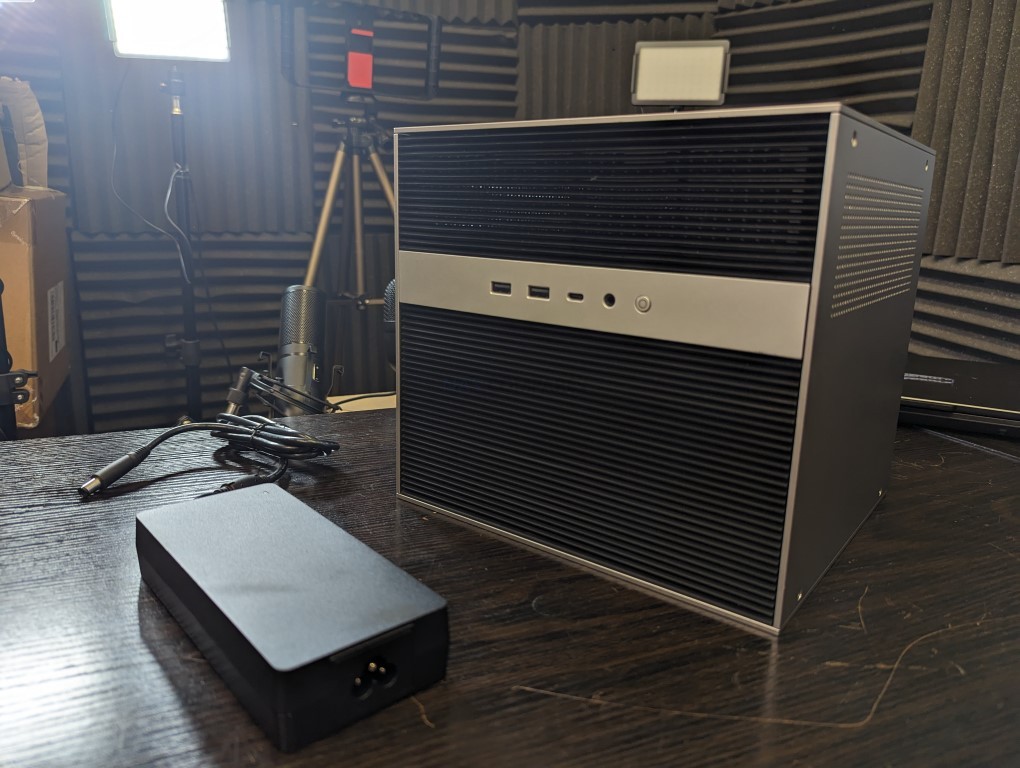
Disclaimer – Where are the Power and Noise Tests?
This article is about taking the ZimaCube NAS apart and finding out more about its hardware architecture. There will be users arriving at this guide who are going to want to know why I have not included temperature tests of the system when in operation and power consumption tests. These are definitely, definitely going to be tests I’m going to perform; however, a large part of the effectiveness of these and the measurable benchmarks is going to be heavily focused on the efficiency of the Casa OS running on this hardware. The Casa OS NAS software has already been around for a few years in the Zimaboard and Zimablade systems, and the ZimaCube prototype I received included this software. However, Ice Whale have told me that a more featured and system-developed version of this software is being rolled out with the ZimaCube, which arrives with significantly more horsepower across both its standard and pro versions than the previous two Ice Whale single board server NAS devices. Therefore, measuring the performance and efficiency of this system with the software it currently arrives with would not be a fair test, and therefore I am holding back on these more operational focus tests for when the intended software update is rolled out.
ZimaCube NAS N100 Teardown Start
The ZimaCube system was not shipped to me in the retail packaging, but rather in a plain brown box with protective foam surroundings. Nevertheless, the system did arrive with the enclosure completed, as well as its external PSU included as well. There was no accessories kit, but I am sure this is something that will be addressed much further down the line during intended fulfillment and retail. The chassis was pretty much identical to all images currently shown by the brand on their Kickstarter pages. The chassis is metal on all sides, with each of the ventilation panels in plastic material. The front-mounted panel utilizes a magnetic attachment system in four corners, whereas all other ventilated panels are held in place with hinges hooked into the edges of the enclosure.
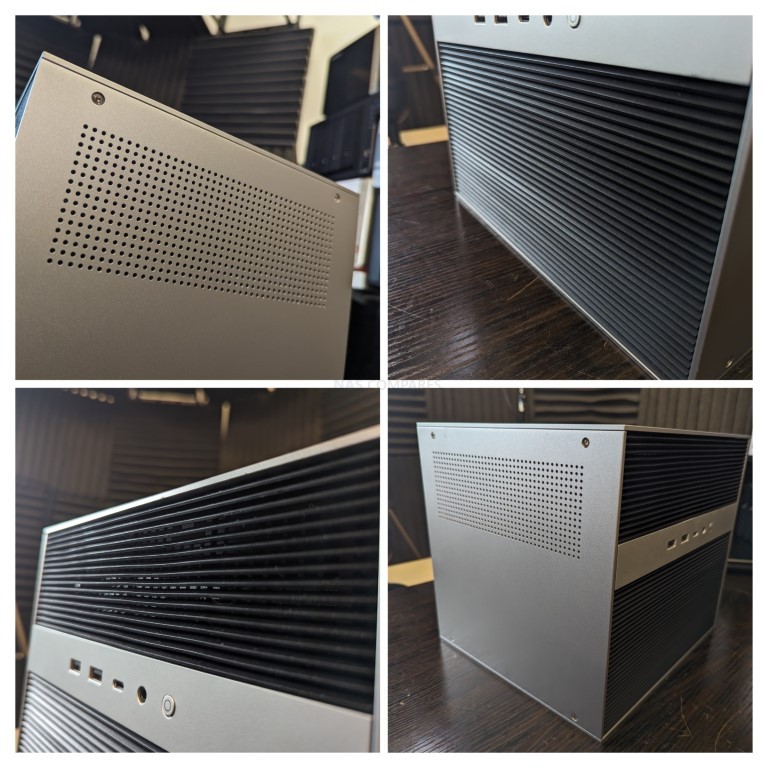
As previously discussed, the ZimaCube arrives with six SATA storage bays and an additional PCB tray-loaded module that houses two or four M.2 NVMe SSDs. To access this storage area, the front panel needs to be removed. As much as I like the streamlined and understated aesthetic of the ZimaCube, removing the front panel is not as easy as I would like, and I think a small handle, small separate pull tether or something along those lines would really help in removing this panel in the long term. It is a small complaint, but when you look at similar chassis designs in the Jonsbo N2 and N3, which both use the same understated vented front panel, they include a small fabric protruding element that allows you to remove the case easily. The ZimaCube doesn’t really have any aperture with which you can leverage that front case off easily.
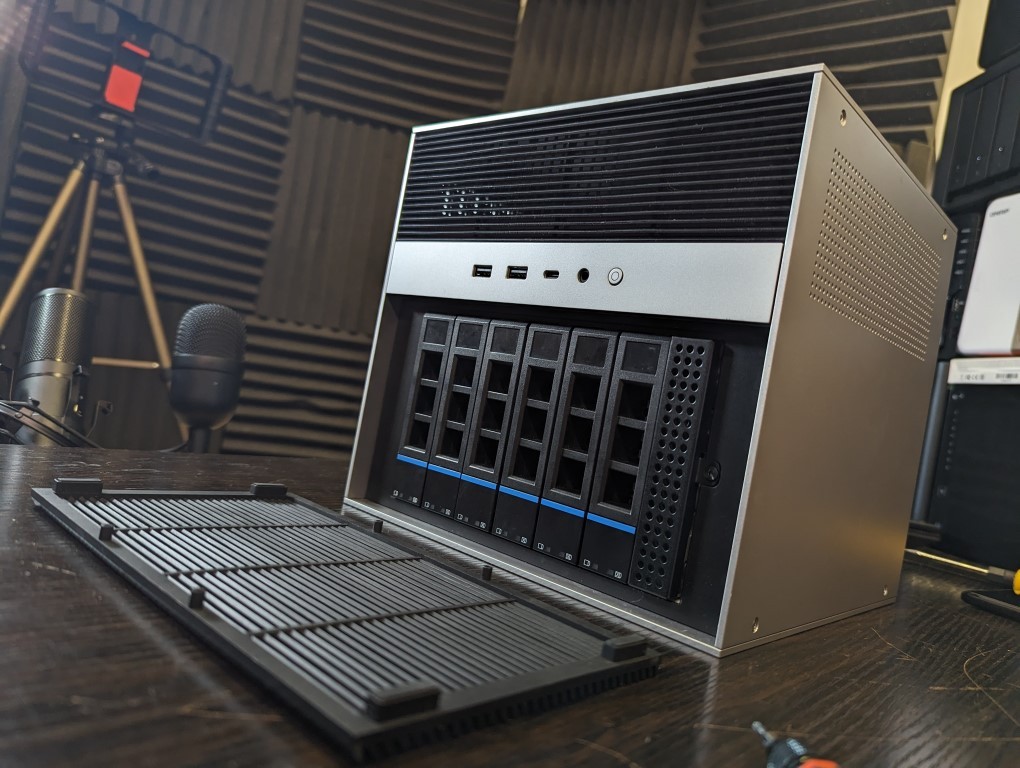
The SATA trays are all pretty high quality, spring-loaded on the handle, and although they cannot be locked, they do feature LEDs running at the base of the tray panel. They are quite a snug fit inside the chassis, and they have definitely used every available millimeter in order to populate this enclosure with six SATA bays and that M.2 module, but nevertheless, these are pretty good quality trays and also include pretty clear instructions for the installation of different types of media.

Removing all of the trays shows us a pretty clean internal backplane. Each of the individual connectors is combined SATA and data, and there seems to be a good surround of ventilation around this internal storage cage. You can make out the two active rear cooling fans which, although beneficial, I will be interested to see how air flows throughout this system and over the motherboard and CPU cooler located above the hard drive cage, as (and I will go into more detail on this later on) these are the only two active cooling fans in this system, which is always good news. Noise-wise is something of a question for the more aggressive i5 pro system.
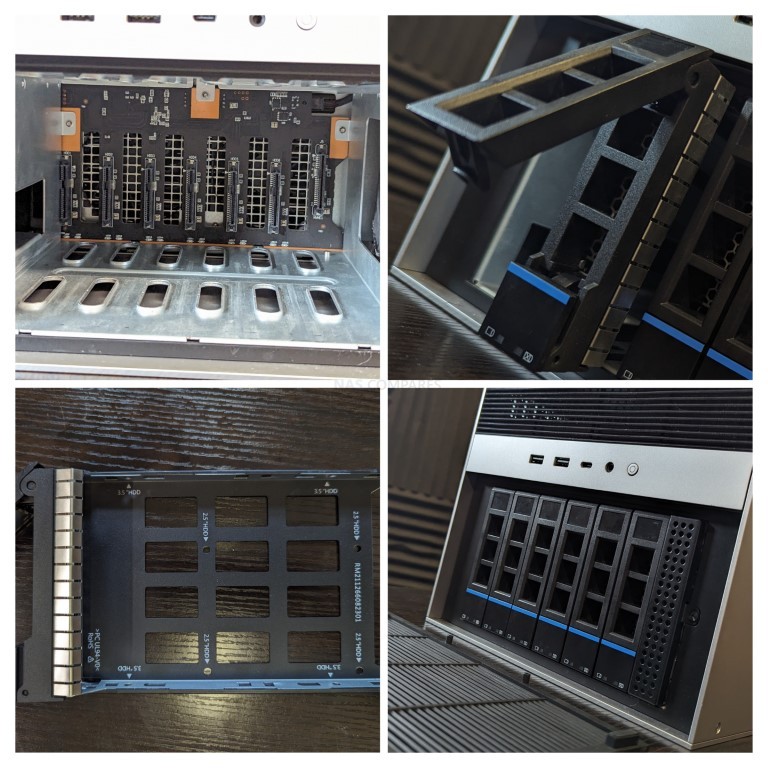
The M.2 module connects to exactly the same backplane as the rest of the main SATA storage bays but interfaces into a U.2 connector on this board that is slightly out of alignment with the rest of the data bays – nothing wrong with that, and if anything, I’m pleased to see that they have separated it with its own interface and lanes. No doubt. Removing the module is nice and straightforward and is done so with the removal of a single hexagonal screw located on the front. This totally makes sense, as unlike the more hot-swap supported SATA drives, the M.2 caddy is one that is going to be less stable upon hot-swapping attempts.
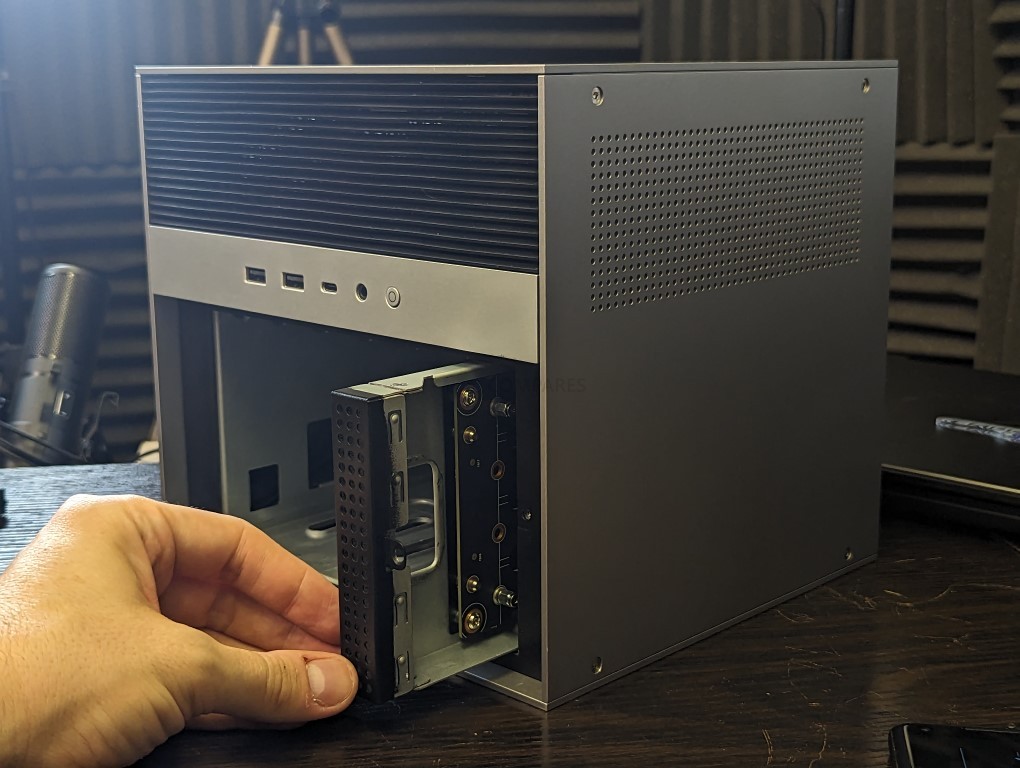
The U.2 connector that this M.2 caddy interfaces with is largely identical to the SATA connectors, but clearly, this is where space has been at a premium and this module is a little bit more stylized as a 9.5 mm width drive. Nevertheless, injection and removal are very clean and there is little chance of missing the interface during use.
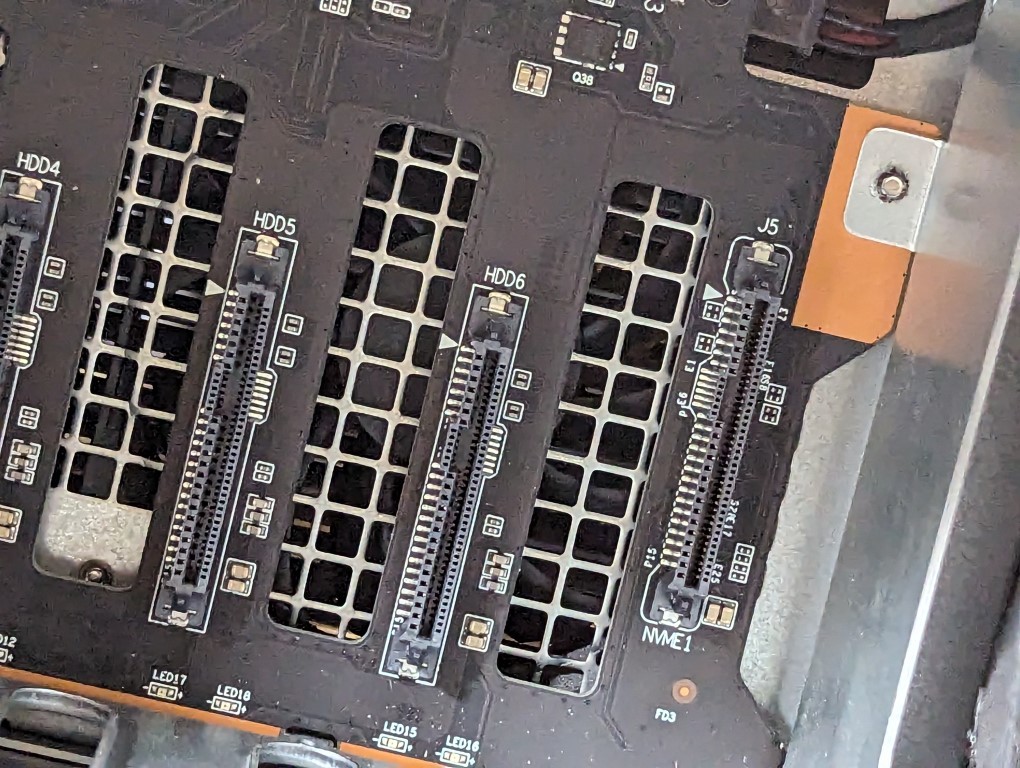
The M.2 PCB contains either two or four drive interfaces, depending on which version of the ZimaCube you choose to use, and I will go into a lot more detail in a later article about lane distribution on these and on the rest of the system. Once again, space is at something of a premium and if you do choose to use M.2 heatsinks in this drive area, you are going to have to utilize moderately low-height ones in order to not interfere with the already full hard drive cage.
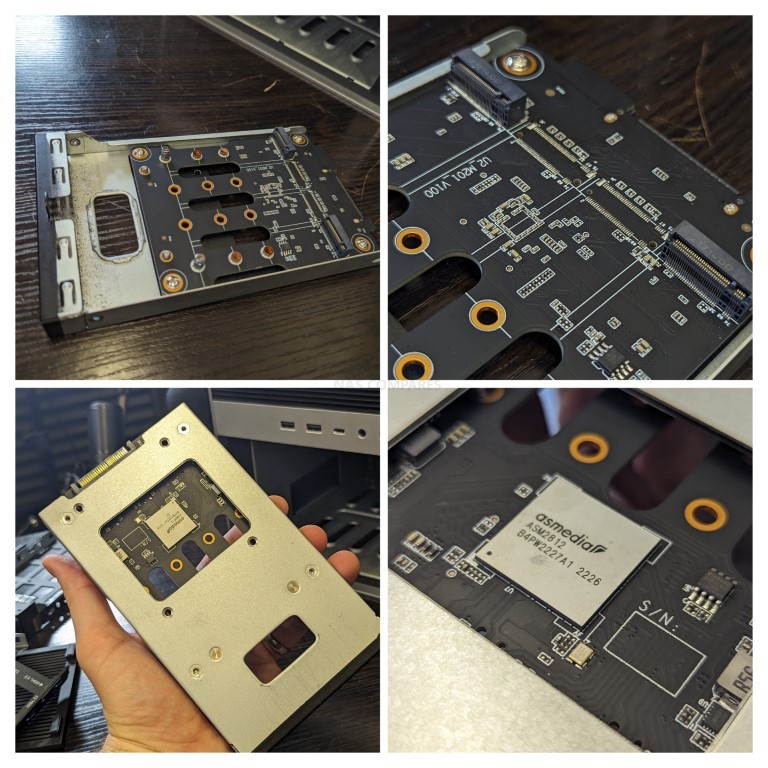
On the base of the M.2 module, we find an ASMedia PCIe chip that no doubt is bolstering these individual drives in order to leverage a little bit more lanes and speed. This is not unusual and something we have already observed in the case of the Flashstor from Asustor, but nevertheless, it also confirms that this system is really stretching the availability of those lanes and the speeds afforded to them.
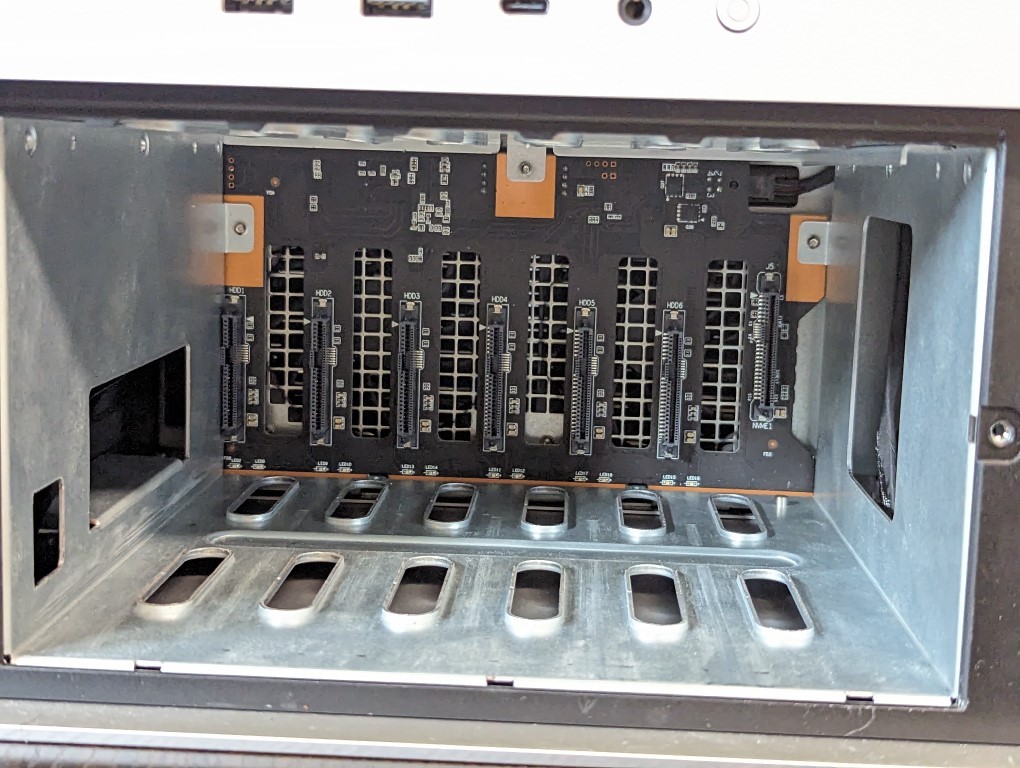
ASMedia PCIe product ASM2812, a low latency, low-cost, and low-power 12-lane, maximum 6 downstream ports packet switch. With upstream PCIe Gen3x4 bandwidth, ASM2812 can enable users to build up various high-speed I/O systems, including server, system storage, or communication platforms. As this is the non-pro version of the ZimaCube system, I cannot confirm yet if this additional PCIe controller is present on that higher-spec device or even if the interface utilizes the same U.2 connectivity. Though I can imagine that they will either be largely similar or pretty much identical. Next, I wanted to remove some of the plates and panels around this system to get a better look at the internal cage of this NAS.
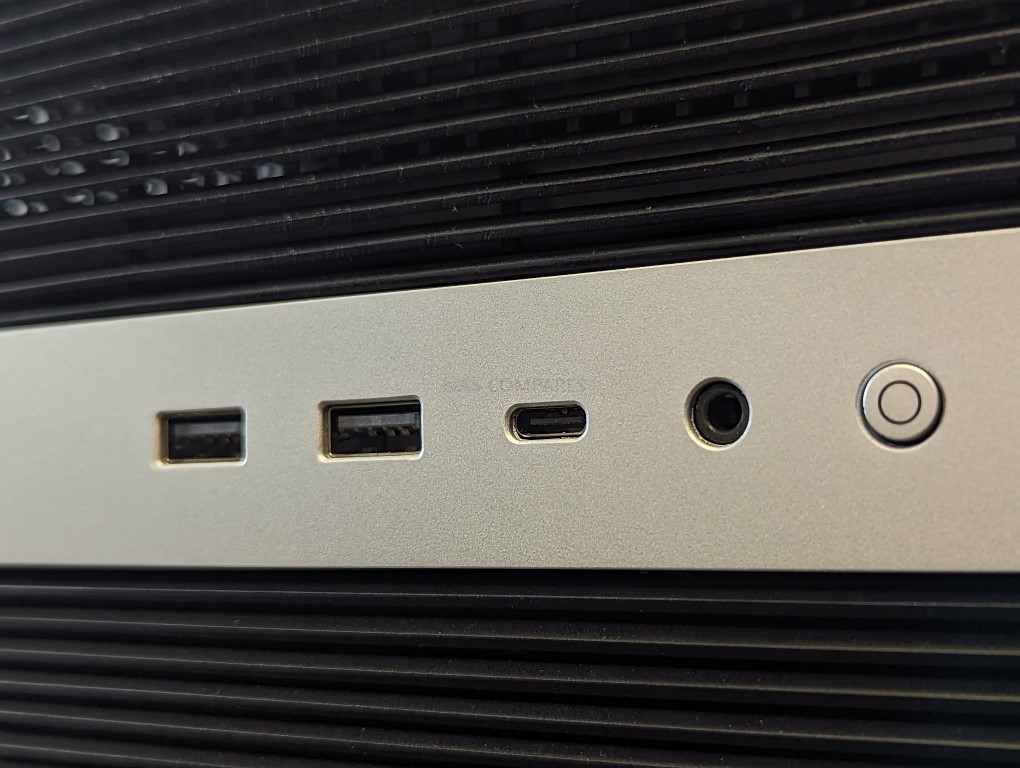
The front panel ports are exactly as Icewhale detailed in their initial Kickstarter details, with the N100 version of the ZimaCube featuring a combination of USB Type A and Type C as needed (as well as audio in/out). The panel just above this is another fully ventilated panel and behind it is the metal chassis that is also completely ventilated throughout. On the ZimaCube Pro, the system benefits from the front-mounted USB-C port being Thunderbolt 4! I will be curious to see how the motherboard factors this in, as well as the potential heat generation associated with heavy TB4 use. Let’s look at the rear panel.
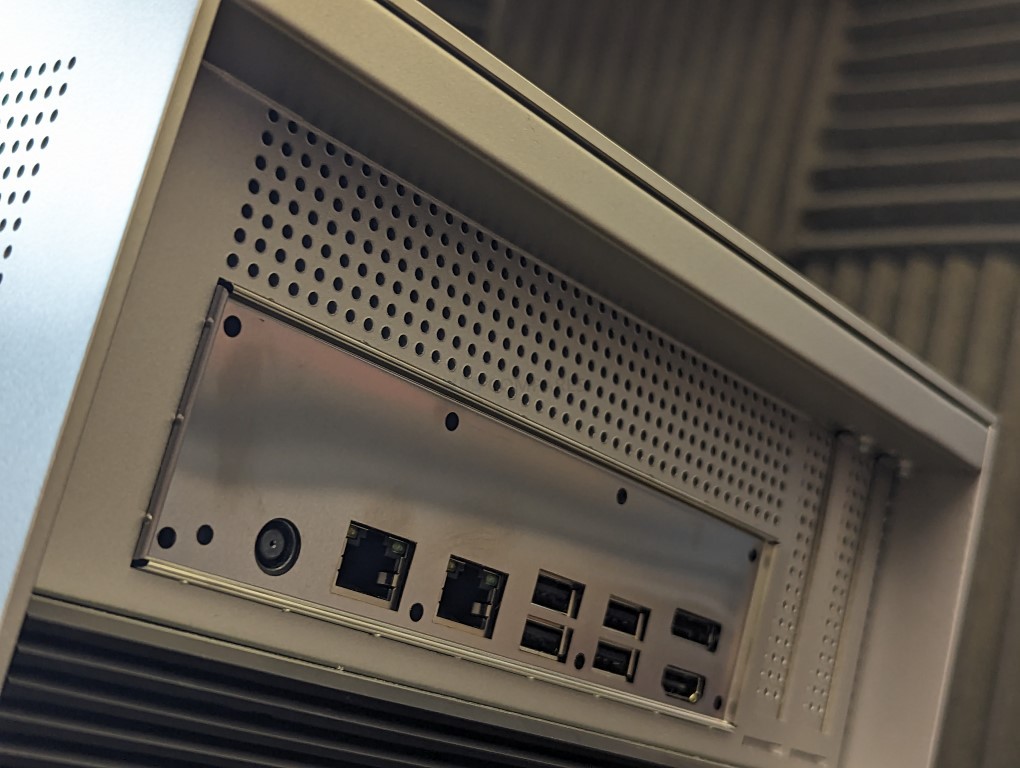
The rear ports of the N100 Zimacube model are all pretty familiar stuff, more USB ports, 2x 2.5GbE network connections and twin visual outputs in the form of a displayport and HDMI (both 4K 60FPS) – though I have yet to confirm if these mirror one another or the software and architecture allows for multiple displays. There is also the PCIe upgrade slot that allows for greater network connectivity. I completely understand why the N100 lacks 10GbE (to a point…), as integrated 10GbE onto this motherboard would be complicated and likely jack the price up – when there are other ways to achieve this for interested users looking at the N100 later. However, I am still a little surprised that the i5 Pro version lacks 10GbE and instead arrives with 4x 2.5GbE. TECHNICALLY this is 10GbE (with the right port trunking/aggregation/SMB Multi/load balancing/etc support), but with this amount of storage bandwidth across HDD and SSD available (even if you limit the M.2 NVMes to 3×1 or 4×1), its a shame that 10GbE isn’t standard in the Pro. Passive ventilation holes are present on pretty much every side and I am particularly pleased to see an especially large ventilation panel on the system’s right side, where you would find the PCIe slot (backers of the more advanced Kickstarter tiers have been looking at the GPU equipped models, with active cooling on board). But, let’s be honest – it’s whats inside that counts! Let’s get those side panels off and have a butchers inside.
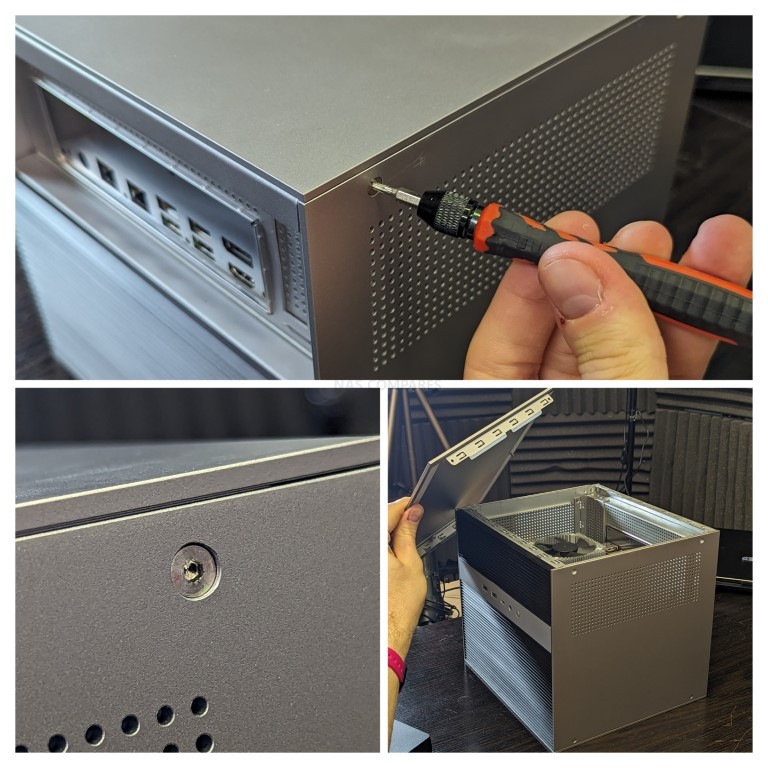
Full credit to Ice Whale on the ZimaCube NAS, unlike a lot of more affordable NAS systems that leverage the use of plastic external chassis with metal internal frameworks, the ZimaCube is pretty much all metal, which is going to be great for heat dissipation (though that does mean questions about noise in operation, of course, from vibration). Each side, as well as the top and base panel, are removed via 4 hexagonal screws in either corner. They are hooked in multiple corners and come off easily but also at the same time do feel very securely attached.
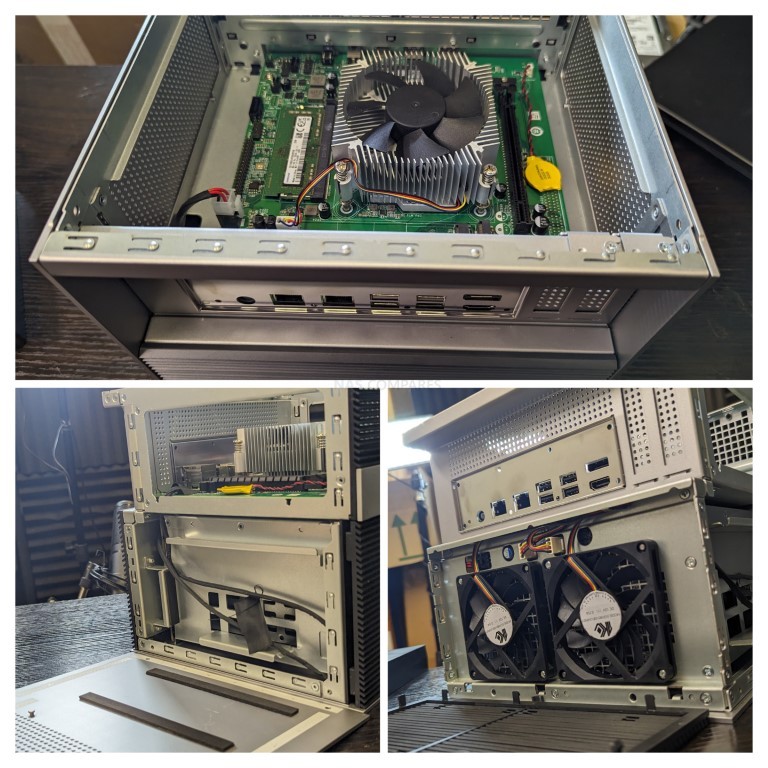
Removing both of the side panels allows you to remove the top panel, as these three pieces overlap at the top joints. This reveals a rather snugly fit motherboard. As discussed numerous times here on the blog, as well as in the crowdfunding campaign, I’m sure, this is a pretty compact system for this amount of storage, and although I’m not surprised that the mITX board inside is pretty tightly fitted, I’m still amazed at just how much they’ve packed in here. It’s already pretty apparent why they abandoned the inclusion of an internal PSU here, as notwithstanding the utter lack of space that would have ended up infringing on storage potential, it’s a great deal more elegant for this kind of design to have an external PSU that feeds into a single modest power cable running through the system connected to the mobo and the storage backplane respectively.
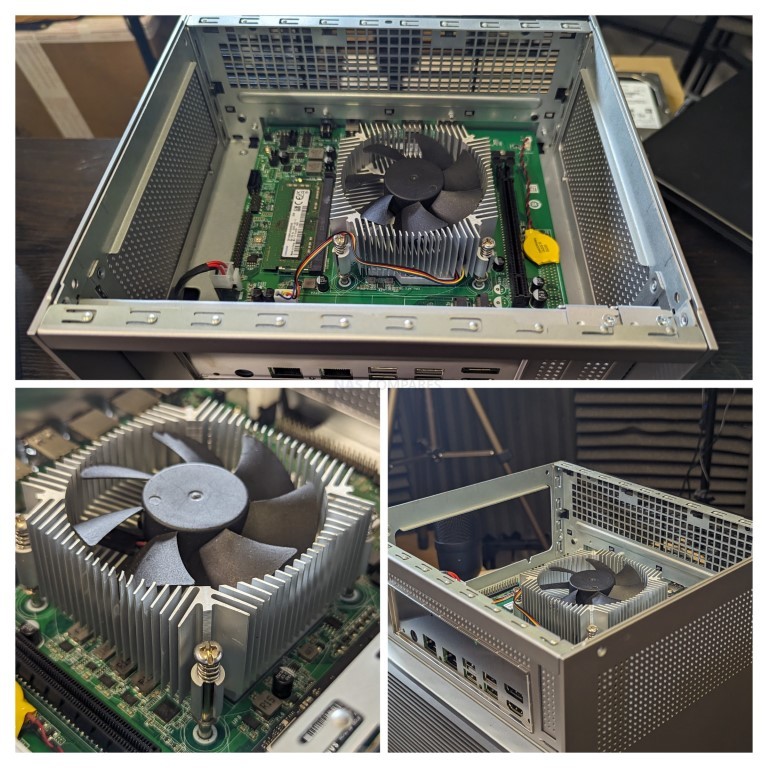
As this is the slightly more modest Intel N100 version of the ZimaCube, the CPU fan does not need to be too crazy in comparison to that of the i5. Nevertheless, after running multiple reviews on Topton motherboard built systems, I’m actually quite impressed by the CPU cooler that this system arrives with. Whereas most Topton boards that run on modest Celeron or Pentium processors arrive with an exceptionally low-profile CPU cooler, the N100 here is placed under a much more substantial CPU heatsink and fan. It’s not exactly enterprise-level, of course, but given the economies that this system is designed with in mind, the CPU fan is better than I was expecting. Note, I resisted the urge to remove the CPU fan and take a closer look at the CPU largely because I did not want to compromise future testing of this device. Nevertheless, I will update this article and future articles later with details on this when I run the more evolved Casa OS software and system benchmarks first.
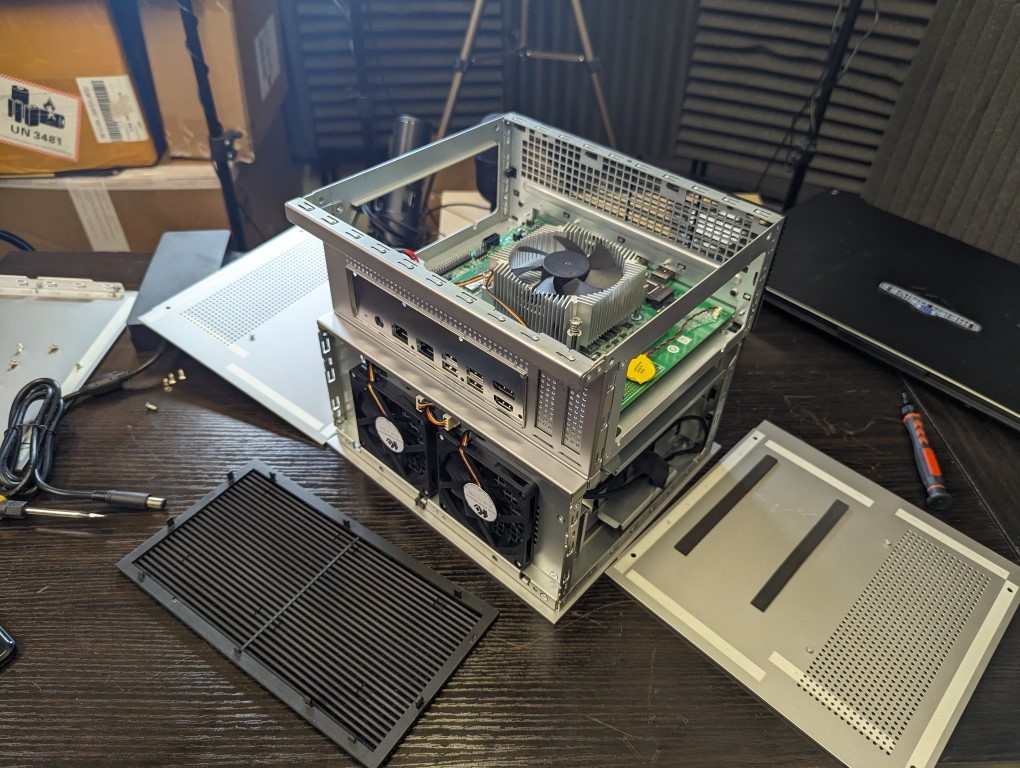
The onboard memory that this prototype arrived with was 8GB of DDR4 non-ECC SODIMM memory. The system features a single SODIMM memory slot and, given this CPU supports a maximum of 32GB, that means one SODIMM slot should be enough. Once again, a lot of more economical systems have a tendency to cut corners and increase efficiency in those systems by opting for pre-soldered individual memory modules attached to the motherboard. This often results in the inclusive memory being more affordable, but also limits any kind of upgrade or flexibility in the amount of memory you need. Therefore, much like the CPU heatsink, I am impressed that they opted for a traditional removable SODIMM slot here.
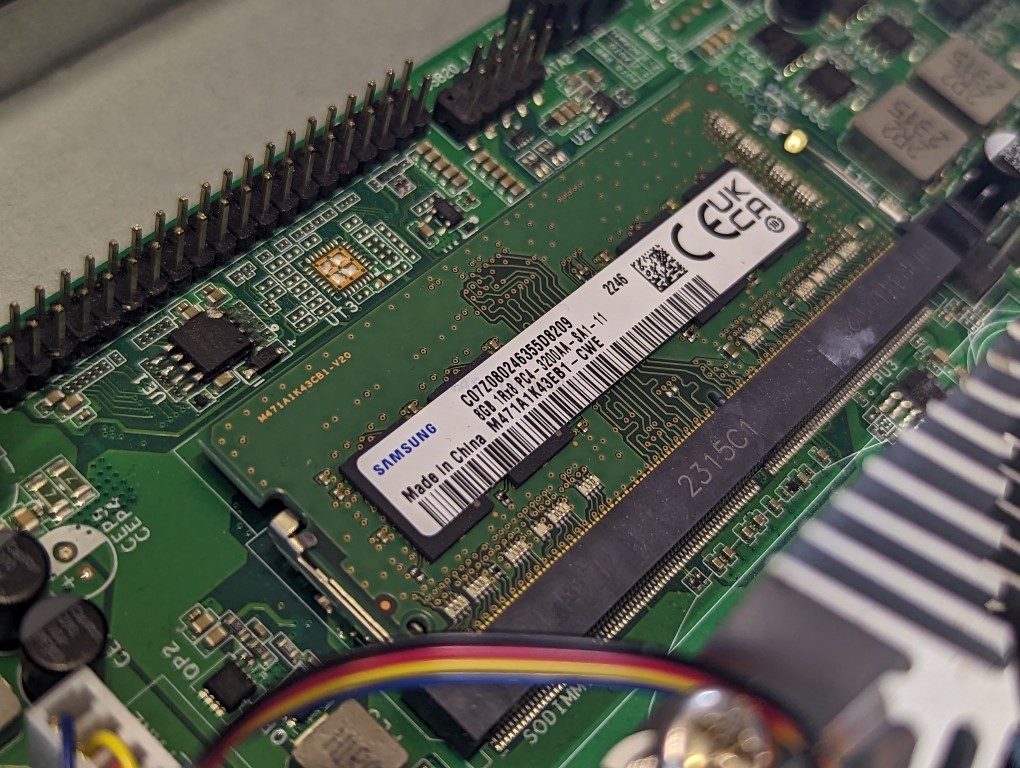
The Casa OS runs on an included NVMe SSD, in this case, a Samsung 980 Gen 3 SSD. It isn’t a huge SSD in capacity, but then again it does not need to be and once again just goes another step towards keeping this system affordable. It is still too early to say whether, if this system completes its crowdfunding and fulfillment is reached, whether all systems will be utilizing a similar known branded SSD for the operating system – this is once again another area in which some brands will cut corners and go for unbranded SSDs for OS drives. We’ll have to wait and see on that one. As the system is using an mITX motherboard, there are the inevitable question marks around SATA ports. This system has a lot of SATA storage to handle and it is always interesting to see how different NAS developers get around the low number of ports afforded to mITX motherboards. Originally, I assumed that these six storage bays would be connected to an M.2 SATA adapter, or perhaps, an auxiliary board connected at an angle to the base of the motherboard by PCIe. However, on closer inspection of the motherboard inside the ZimaCube, it turns out that this system isn’t even using the available SATA port that it arrives with and instead has a very different method in mind to connect that additional backplane for the SATA drives.
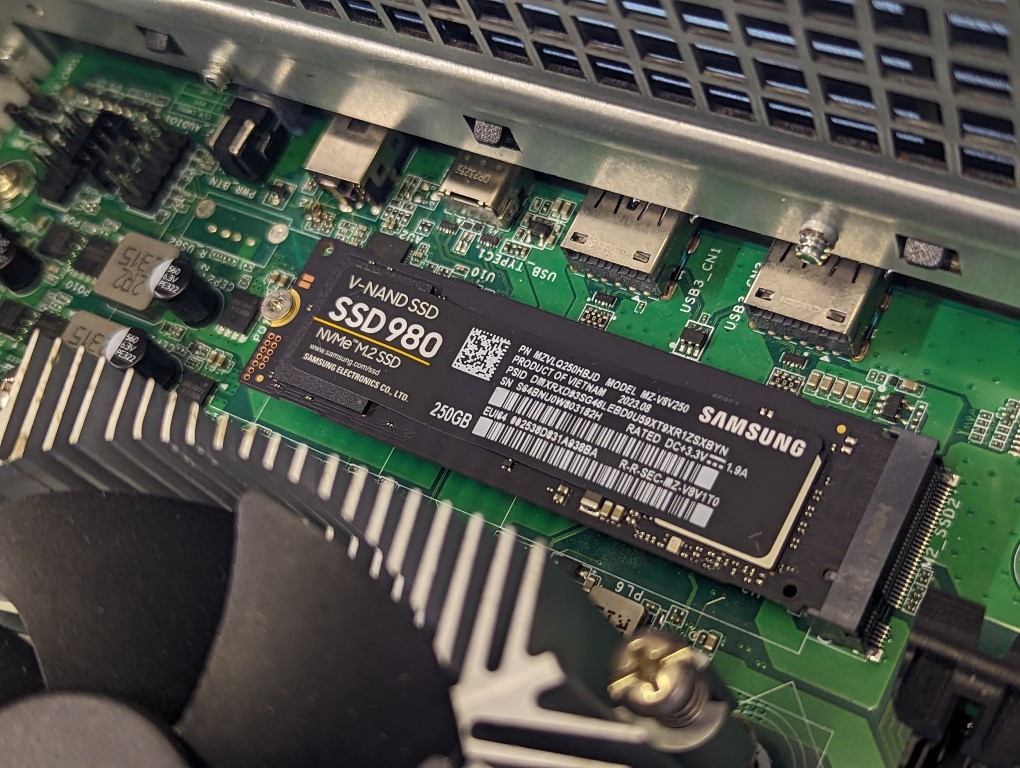
As mentioned in the early promotional materials for this device, there is an additional available M.2 NVMe slot on this motherboard which can be used for further drives for storage, caching, and more depending on the operating system you would intend to use. We are still awaiting further confirmation of how the improved Casa OS is going to manage and allow users to configure storage drives. So the true abilities of this M.2 slot are yet to be confirmed in line with the operating system, as well as support of third-party peripherals too. Nevertheless, this still means that even the N100 model of the ZimaCube is arriving out the gate with six SATA bays and four M.2 bays spread over two different areas of the system. For a price tag of $400 to 500, that is pretty unique in the market. Additionally, closer inspection showed that it wasn’t just a standard M.2 connector, but actually a twin-layered interface that allows you to use not only a standard 2280 length SSD, but also install a much smaller M.2 underneath. Once again, this is not unusual and often some AliExpress motherboards provide this in order to maximize space to add an M.2 network adapter or to use SATA multi-lane M.2 adapters. Although I’ve yet to get full confirmation from Ice Whale that this is a 100% unique board, or a modification of an existing board (or perhaps something in between), it will be interesting to see what is possible with this two-tier M.2 connector.
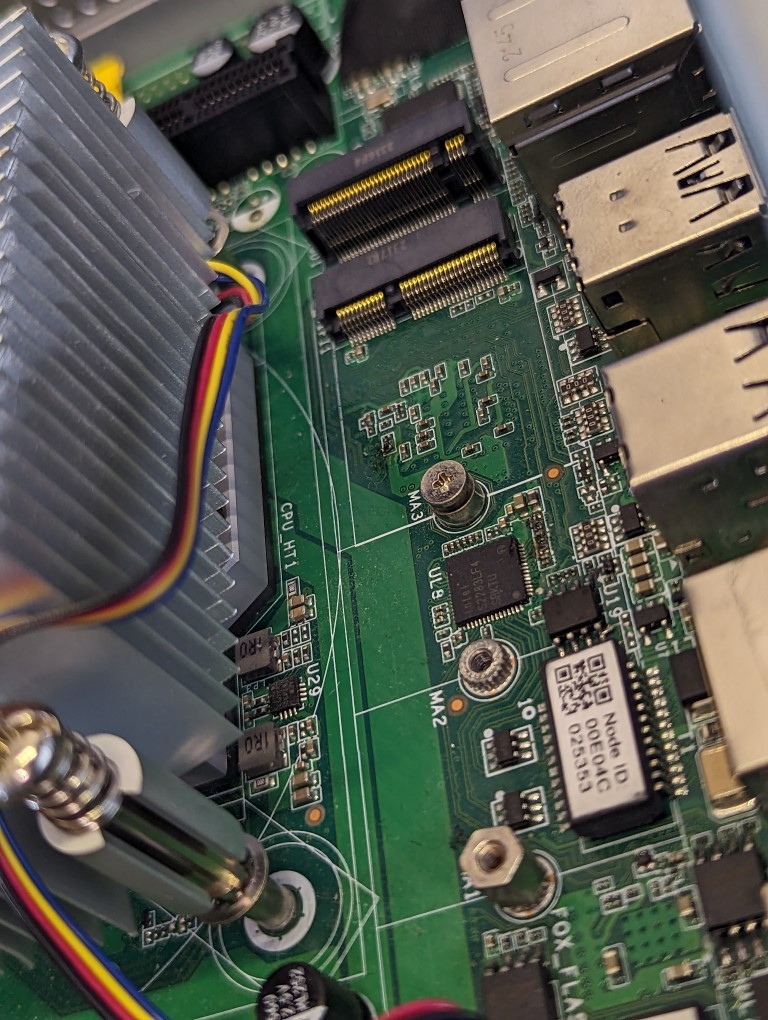
One slight area of confusion is the PCIe slot on this motherboard. I can appreciate that a lot of the components are going to be shared between the standard N100 version of this system and the pro i5 version, as they’re going to be going through similar methods of mass production if this crowdfunding campaign reaches fruition. However, the initial specifications provided by Ice Whale on this system said that the N100 version arrived with a PCIe Gen 3 x 4 slot. However, the prototype I have here clearly has a much larger speed PCIe physical interface. Now, perhaps this is the speed that is afforded to the system layout and this physical slot is simply a case of them reusing the same components across development on multiple systems. Indeed, when you look at the previous single board servers that this brand produced, these were times four speed PCIe but also included cutouts that allowed you to use larger cards. Therefore, I’ll have to hold out on confirming the PCIe architecture on this system when we do our deeper dive into the backend to see if this is a physical anomaly, or if it is a Gen 4 slot in a x16 physical interface, or maybe even that it has been software downgraded out of necessity. We will have to wait and see.
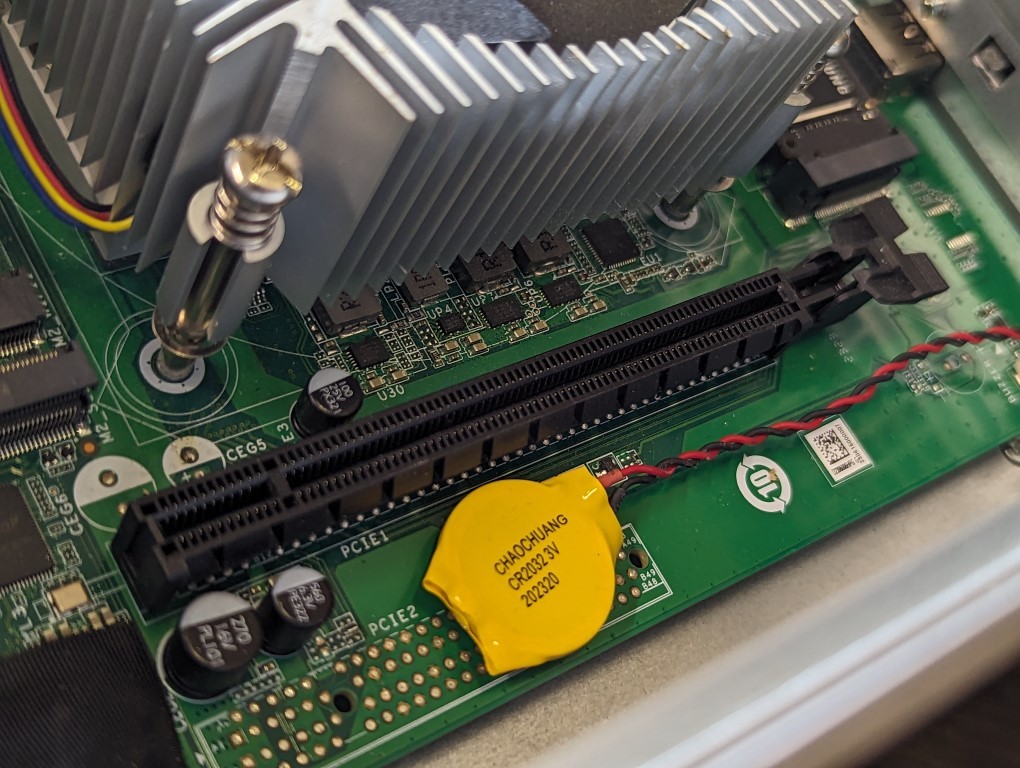
Flipping the motherboard over shows us a very clean board and no further interfaces. Recently, I’ve looked at some of the pre-made mITX boards available on AliExpress, and some boards have provided additional M.2 interfaces on their base. Needless to say, this is not something present here.
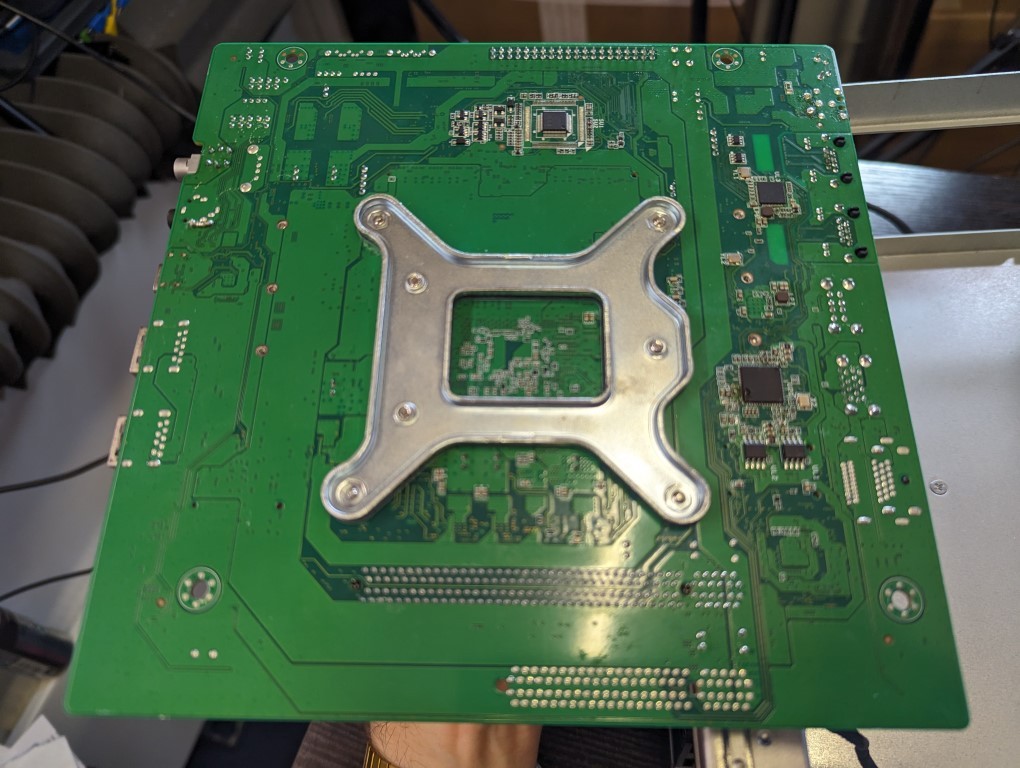
Removing the rear vented panel wasn’t too tricky and revealed two individual active cooling fans. As this system has absolutely tons of ventilation (out of necessity, I’m sure), these two fans are going to have to work pretty darn hard alongside the CPU fan at the top. It’s a very clean installation. The vented panel that lives above these fans, much like the others dotted around this system, is of pretty reasonable quality, I would say, for the price point. It’s definitely plastic and a little bendy, but given the largely exclusive use of metal across the rest of the system, this is absolutely fine.
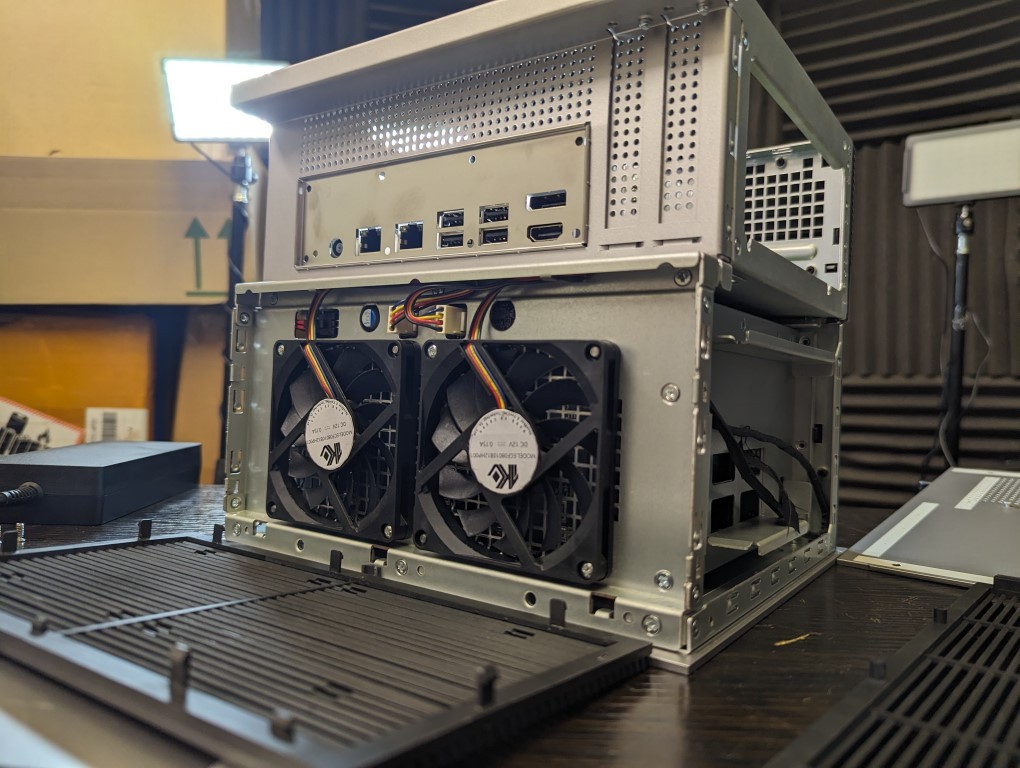
As mentioned earlier, though, I do have questions about the system temperature on the more aggressive pro version, arriving with a 10 core Intel 12th generation i5 CPU. This teardown is of the much more affordable and comparatively modest N100 version, and I do genuinely believe that the inclusive CPU fan and twin rear fans are more than enough to keep this system cool. But it will be interesting to see if further active and passive ventilation and cooling are required on the more aggressive system and whether these two fans should be further supported by smaller fans in one of the two available panels at the front and back of the motherboard cavity. Equally, until I know for certain what the PCIe speeds are on the M.2 NVMe in that module, it’s hard to say at this time how much of a concern heat dissipation is going to be.
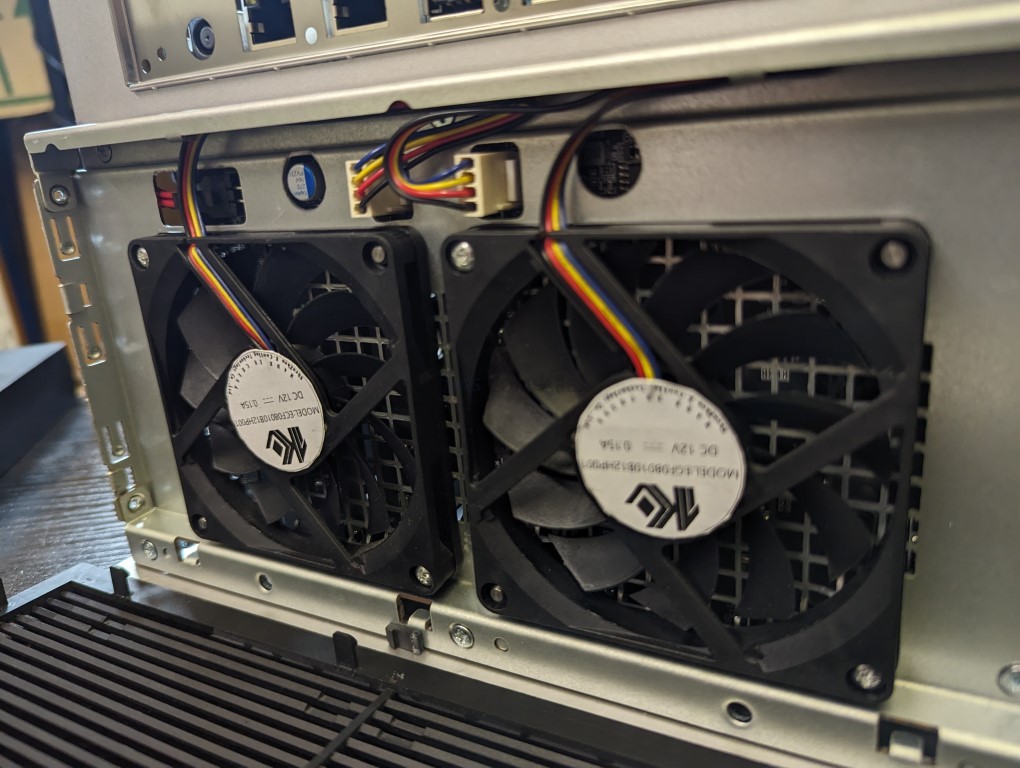
The storage backplane and the main motherboard are connected via a single cable. This really surprised me and was a novel way to get around the traditionally understood limitation of most mITX motherboards having fewer SATA ports. My working knowledge of EDP cables and their bandwidth is pretty slim, and I’m going to have to hit the books a little bit to find out more about the way this system connects these drives to the motherboard.
As mentioned earlier, the two rear fans on the system are the only methods available for active cooling in conjunction with the tons of passive ventilation located across this whole chassis. When you look at the surrounding area where the motherboard is found, there is a ton of passive ventilation available, and I kind of hope that there is at least the option to add further active cooling here, in the event that the i5 runs a little hot. I can’t help but feel that Ice Whale have largely completed development of the N100 model, but the pro series version is still in the closing stages of development. Everything I’m seeing here seems to make a lot of sense and there are some really impressive design choices in order to create a large storage potential box that has a small physical footprint. But nevertheless, I’m not sure a lot of these methods are going to translate one-to-one on the more aggressive system.
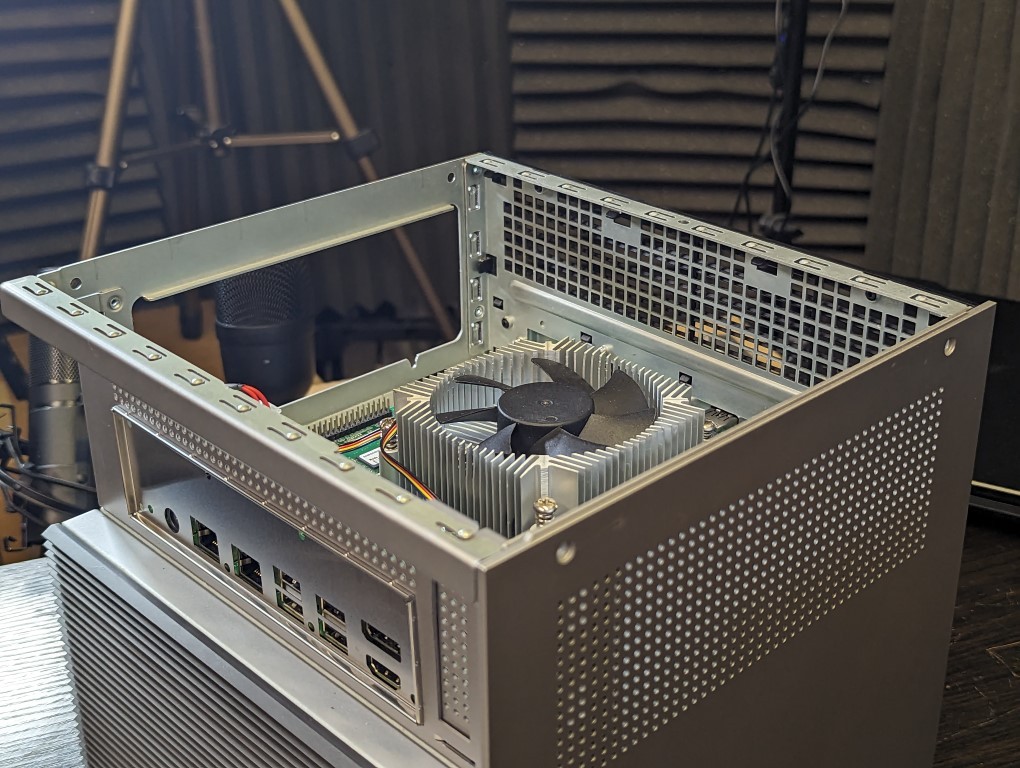
The ZimaCube NAS system features a standard external power jack port, a design choice that significantly contributes to its compactness and storage capacity. By opting for an external power supply unit (PSU), the designers were able to maintain the system’s small size while maximizing storage potential. This approach is in stark contrast to using an internal PSU, which would have inevitably increased the physical dimensions of the device, thus limiting its storage capability. Additionally, the external power connector of the ZimaCube is neatly integrated, connecting directly into an adapted cable that runs into the internal boards. This method differs significantly from some of the cheaper NAS cases available on AliExpress, which are built on Topton or similar motherboards. These often rely on internal power management boards for power distribution, a solution that can sometimes seem makeshift and less reliable, as seen in the CWWK AIO-T6 Power board HERE.
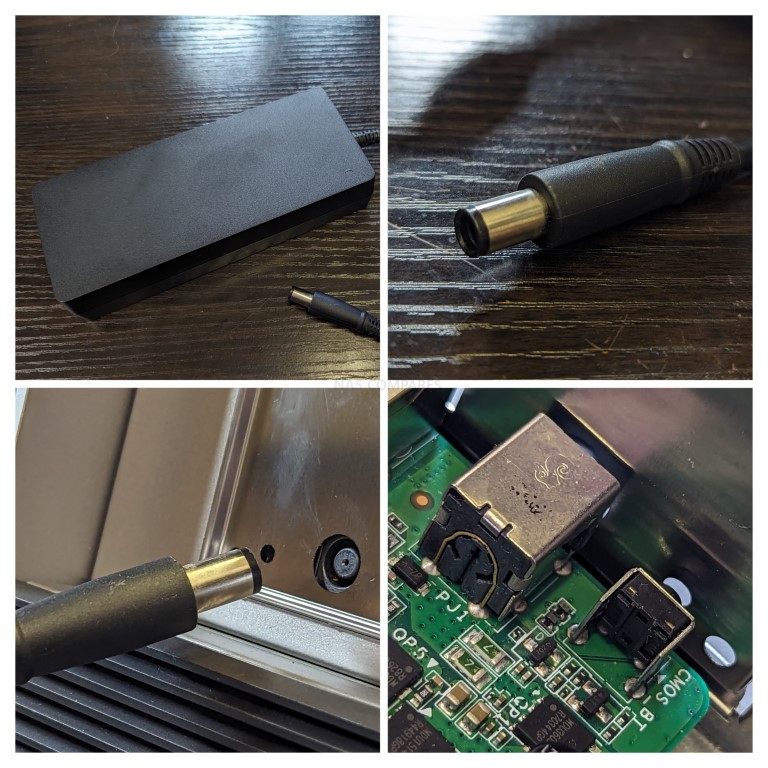
The external PSU accompanying the ZimaCube is fairly standard, rated at 220W. While not from a particularly well-known brand, it fits within the norm for such devices, offering sufficient power without the need for brand recognition. This aspect of the ZimaCube is interesting because it reflects a balance between functionality and cost-effectiveness, a crucial consideration for consumer-level NAS devices. However, it’s important to note that there has not been any confirmation on whether this specific PSU model will be the final choice for both the ZimaCube and ZimaCube Pro NAS devices. Such decisions in hardware, especially regarding the PSU, can have significant implications on the overall reliability and performance of the system, making this an area to watch as the ZimaCube moves from prototype to production. The PSU is connected to a mains cable via a 3 pin ‘micky mouse’ connector.
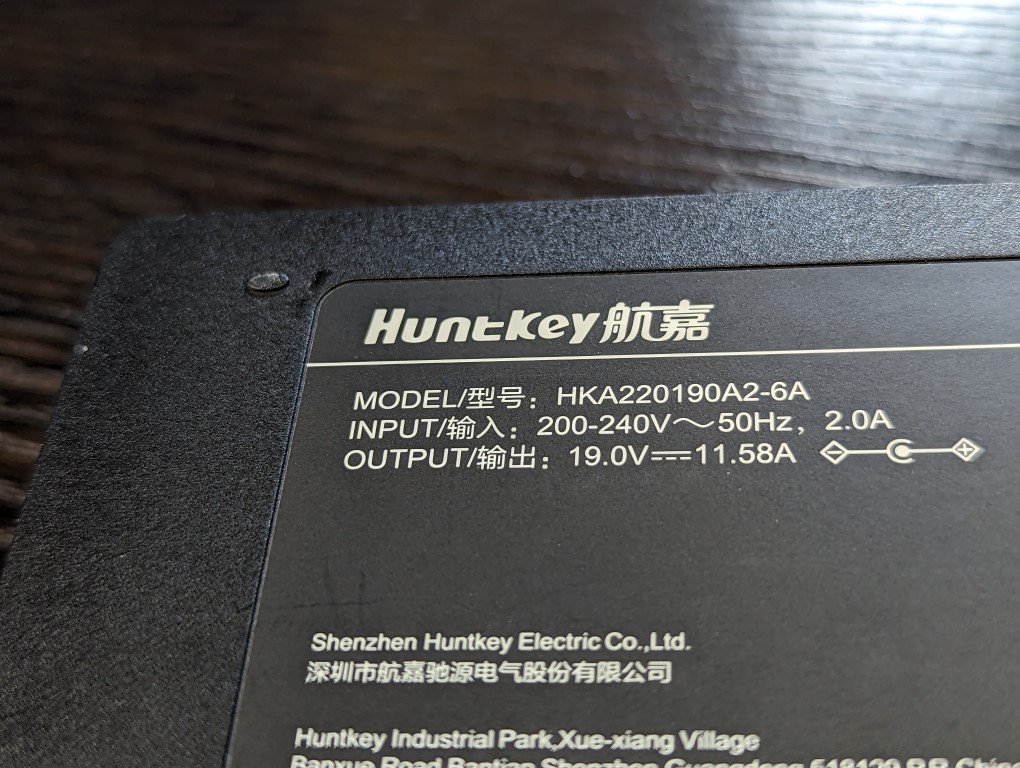
When viewed in its disassembled state, the ZimaCube reveals a thoughtfully designed internal layout, with each component placed to optimize both space and functionality. The image of the device in bits provides a clear view of the internal arrangement, showcasing how each part contributes to the whole. This disassembled view is particularly insightful for understanding the practical implications of design choices like the external PSU. It highlights the space savings and how the internal configuration is tailored to accommodate the unique power delivery method. The decision to use an external PSU, when considered alongside the internal design, underscores the ZimaCube’s balance between compact form factor and robust functionality, a critical aspect for users looking for efficient yet powerful NAS solutions.
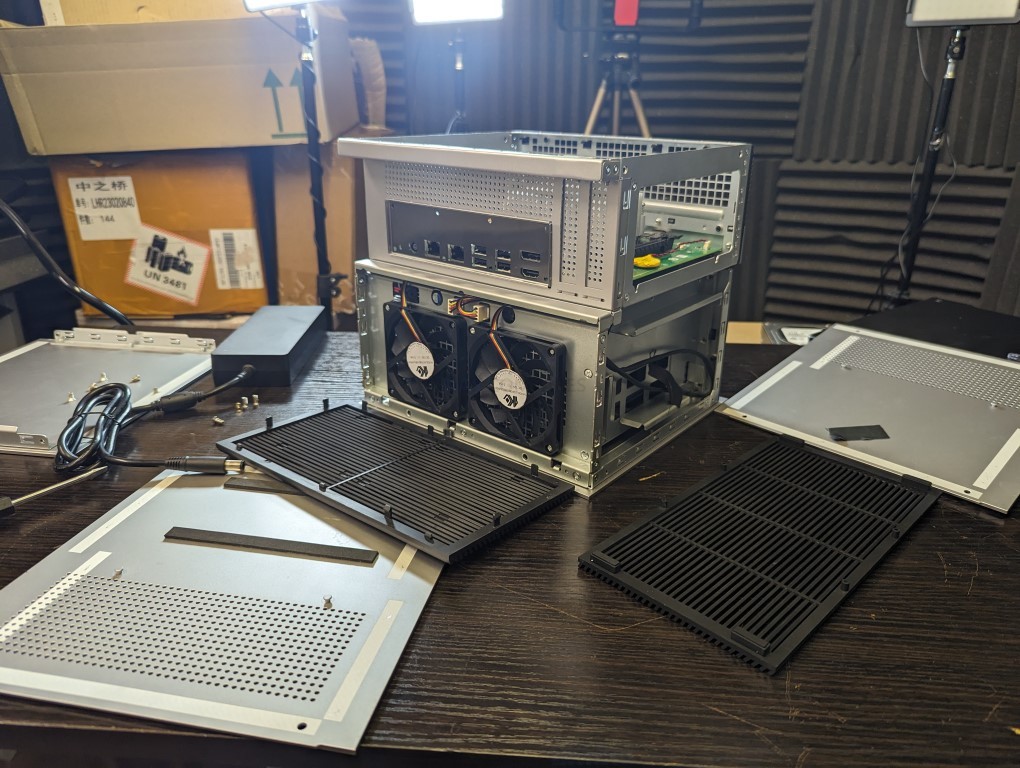
ZimaCube NAS N100 Teardown – Conclusion and Verdict
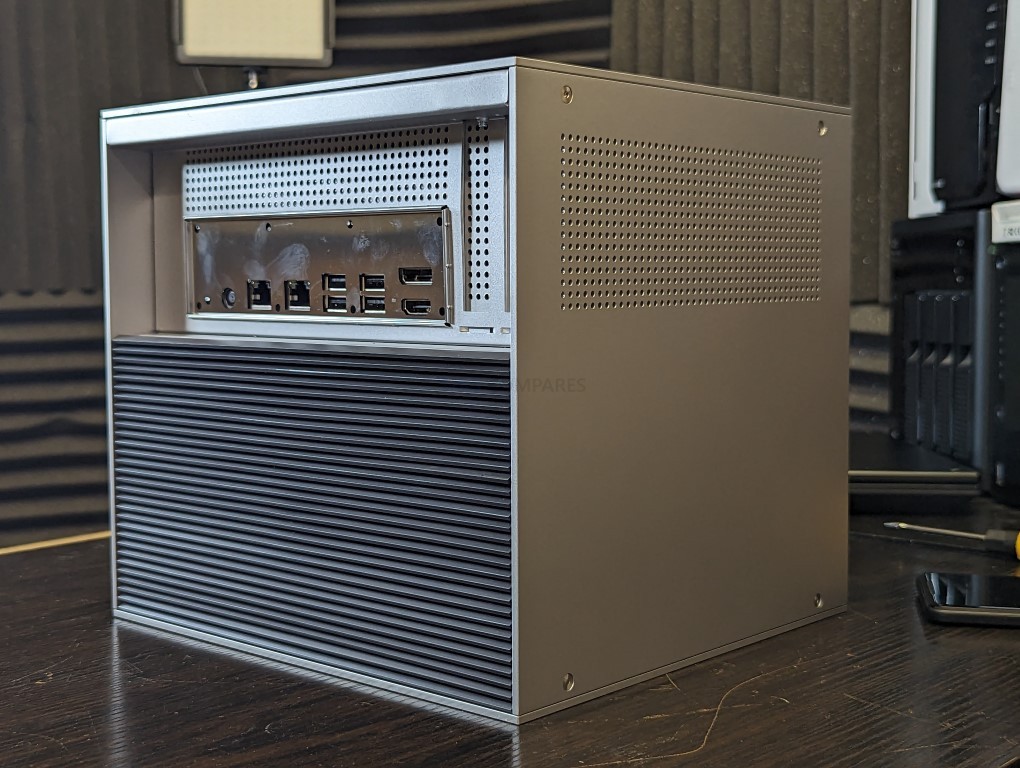
The Ice Whale ZimaCube NAS has real potential to be a noteworthy addition to the compact NAS market right now, as the middle ground between turnkey systems from the likes of Synology & QNAP and full DiY solutions is being split by increasing releases in between!. This prototype showcases a thoughtful internal layout and efficient use of space, particularly in its storage configuration. The innovative design accommodates multiple M.2 and SATA storage bays, maximizing storage potential within a compact form factor. Of particular interest is the cooling system of the ZimaCube. The N100 model demonstrates efficient cooling capabilities, which are crucial given the compact nature of the device. However, the performance of the cooling system in the more powerful i5 model, especially in terms of heat dissipation, remains a point of curiosity and one that will need to be judged on it’s own later on.
The ZimaCube NAS, with its blend of compact design and robust storage options, is poised to be a significant player in the NAS market, especially as this will be the 3rd release by IceWhale (with the ZimaBoard and Zimablade before it meeting largely universally positive responses). As the system hopefully moves from prototype to production, further details about its internal lane allocation, noise levels, system temperature, and power consumption will be vital in understanding its full capabilities.
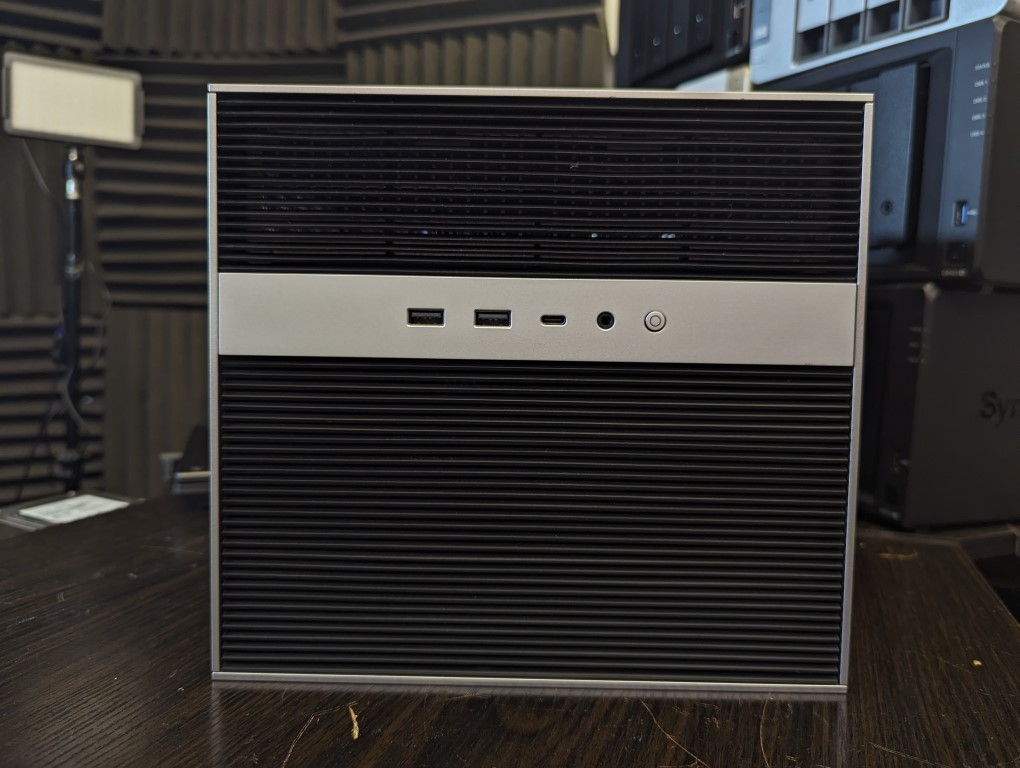
The upcoming release of the latest Casa OS software will undoubtedly provide deeper insights into the overall performance of the ZimaCube, making it a promising option for those seeking an efficient and powerful NAS solution. As always when we are talking about a device that is built on crowdfunding as its means of production, this prototype needs to be viewed as exactly that – a prototype and a hopeful indication of what is to come. In that regard, I am really impressed with what I am seeing in the ZimaCube N100 model NAS and with it’s crowdfunding entry point hovering around the $400-500 mark for the N100 model (depending on how/when you choose to back), I would certainly consider the NAS I have taken apart today to be worth that price tag – especially factoring it against other 6 Bay NAS systems of a similar architecture right now (and even that does not factor in the unique extras like the 4x m.2 NVMe, 2.5GbE and 8GB memory out the gate).
IMPORTANT – This article will be updated with more information as it is sourced from the prototype. Additionally, a follow-up article and video are in the works to explore the system’s internal lanes allocation, noise levels, system temperature, and power consumption. However, these aspects will be covered in more detail once the latest and most suitable version of the Casa OS software is released, providing a more comprehensive view of the ZimaCube’s performance and capabilities. A quick reminder of the key specifications for both the ZimaCube Quad and ZimaCube Octa models:
| Model | ZimaCube
|
Zimacube Pro
|
| CPU | Intel N100 | Intel i5-1235U |
| Cores | 4 Core | 10 Core (2P + 8E) |
| Threads | 4 Threads | 12 Threads |
| Clock Speed | 1.0-3.4Ghz | 0.9-4.4Ghz |
| Integrated Gfx | Intel UHD Graphics, 750Mhx Max | Intel Iris Xe Graphics eligible, 1.2Ghz Max |
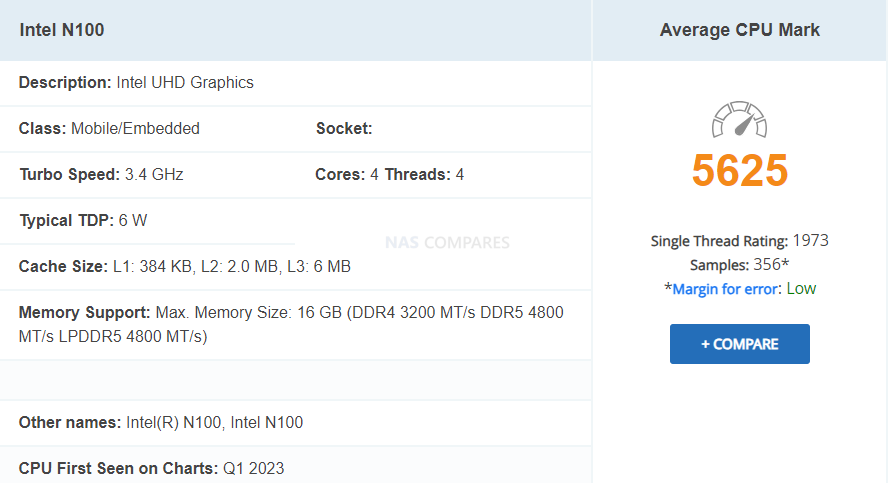 |
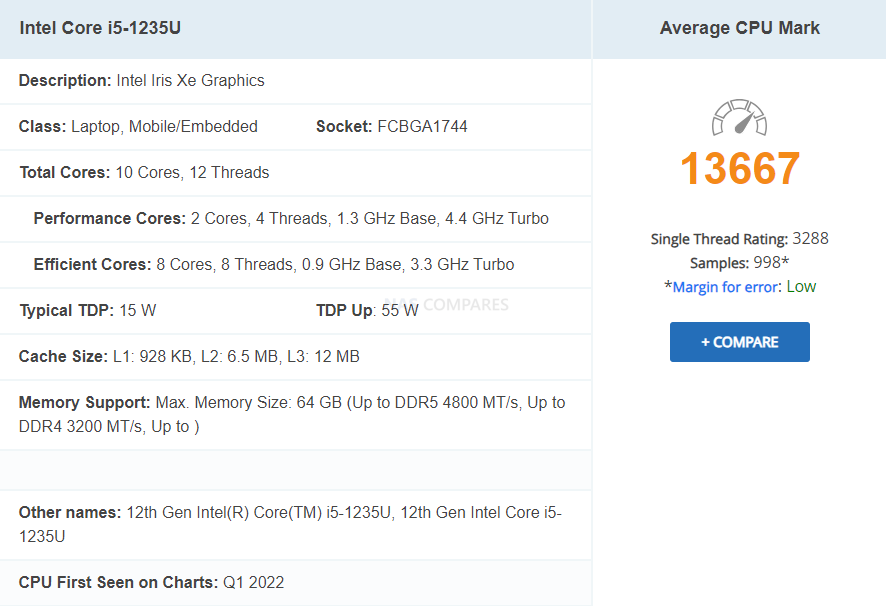 |
|
| Memory | 8/16GB* | 64GB |
| Memory Type | DDR4 | DDR5 |
| SATA slots | 6x 3.5”/2.5” | 6x 3.5”/2.5” |
| M.2 NVMe Slots | 4+2 | 4+2 |
| PCIe Slots | 1x Gen3x4 | 1x Gen4x16 |
| Network Ports | 2x 2.5GbE | 4x 2.5GbE |
| Thunderbolt | No | Yes, 2x Type-C |
| USB Type A | 4x USB 3.2 Gen 1 | 6x USB 3.2 Gen 1 |
| USB Type C | 1x USB 3.2 Gen 1 | 2x (TB4) |
| USB 2.0 | 2X | 0 |
| Visual Output | HDMI 2.0 and Display 1.4 | HDMI 2.0 and Display 1.4 |
| Chassis Size | 240 x 221 x 220mm | 240 x 221 x 220mm |
| Power | External 220W 19V PSU* | External 220W 19V PSU* |
This table provides a clear comparison of the two versions of the ZimaCube NAS, highlighting their distinct hardware configurations.
📧 SUBSCRIBE TO OUR NEWSLETTER 🔔 This description contains links to Amazon. These links will take you to some of the products mentioned in today's content. As an Amazon Associate, I earn from qualifying purchases. Visit the NASCompares Deal Finder to find the best place to buy this device in your region, based on Service, Support and Reputation - Just Search for your NAS Drive in the Box Below
🔒 Join Inner Circle
Get an alert every time something gets added to this specific article!
Need Advice on Data Storage from an Expert?
Finally, for free advice about your setup, just leave a message in the comments below here at NASCompares.com and we will get back to you.
 Need Help?
Where possible (and where appropriate) please provide as much information about your requirements, as then I can arrange the best answer and solution to your needs. Do not worry about your e-mail address being required, it will NOT be used in a mailing list and will NOT be used in any way other than to respond to your enquiry.
Need Help?
Where possible (and where appropriate) please provide as much information about your requirements, as then I can arrange the best answer and solution to your needs. Do not worry about your e-mail address being required, it will NOT be used in a mailing list and will NOT be used in any way other than to respond to your enquiry.
TRY CHAT
Terms and Conditions


ZimaOS is the BEST Beginner NAS OS - Watch Your Back UnRAID and TrueNAS !!!
30TB Hard Drives are TOO BIG ! (and here is why)
COMPLETE UGREEN NAS Setup Guide - 2025 EVERYTHING VERSION
$110 USB4 to 2x10Gb Adapter Review - What the WHAT?
UGREEN NAS Now has iSCSI, 2FA and Jellyfin (and more) - FINALLY!
Seagate 30TB Ironwolf and EXOS Hard Drive Review
Access content via Patreon or KO-FI


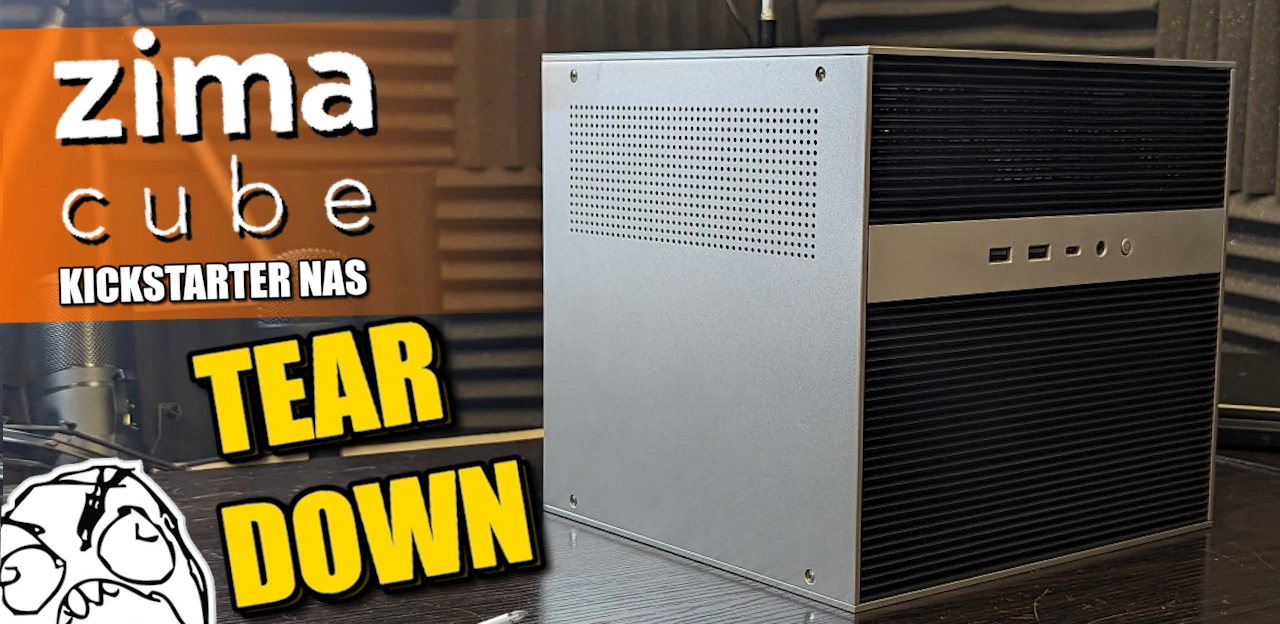
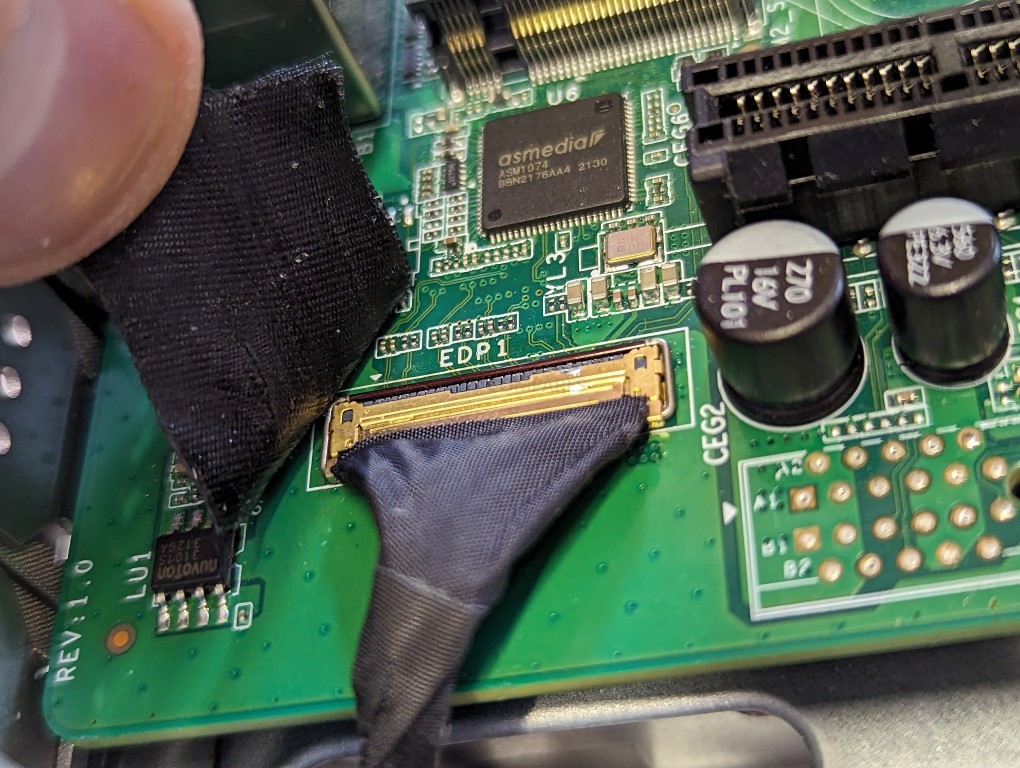
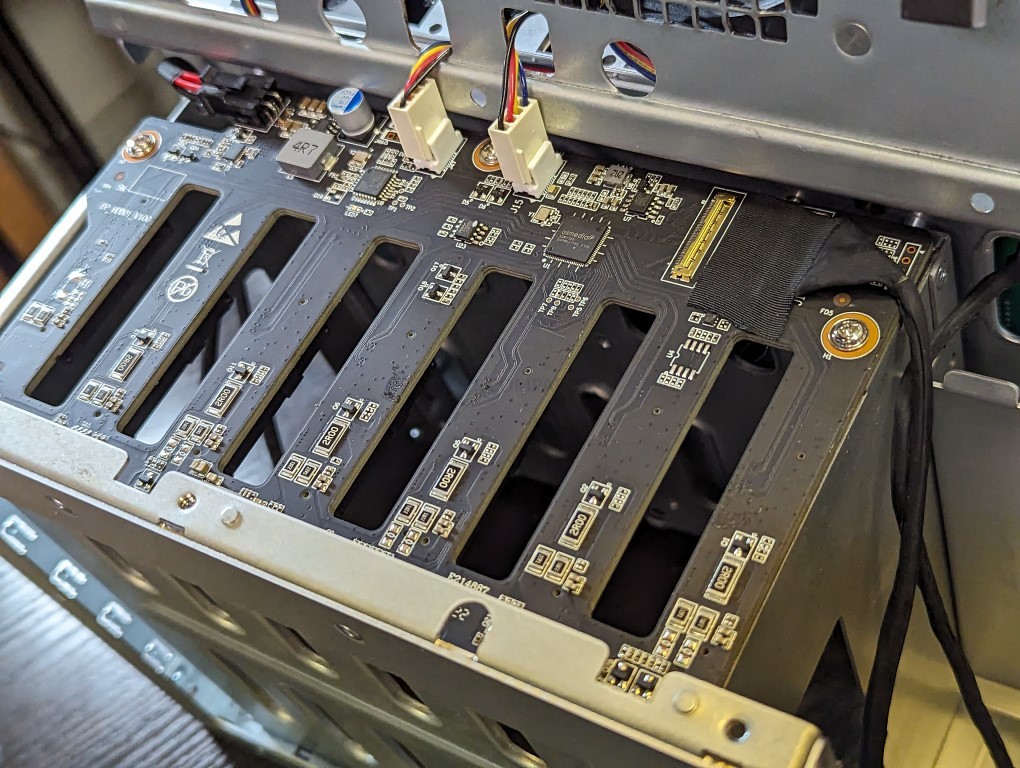
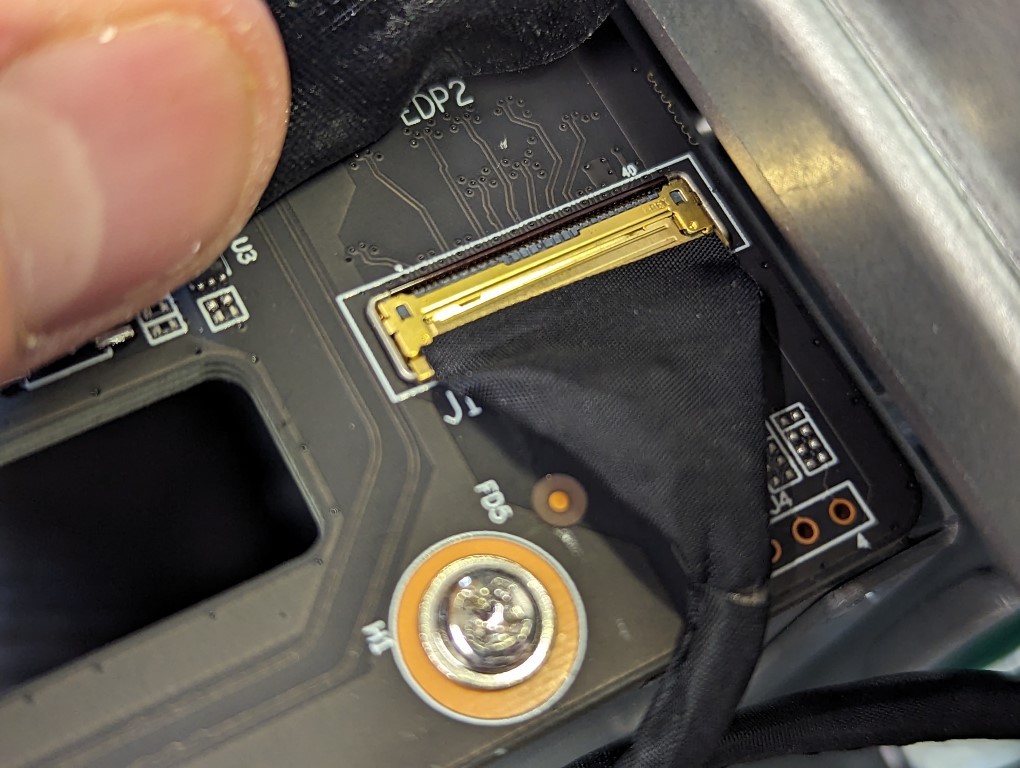
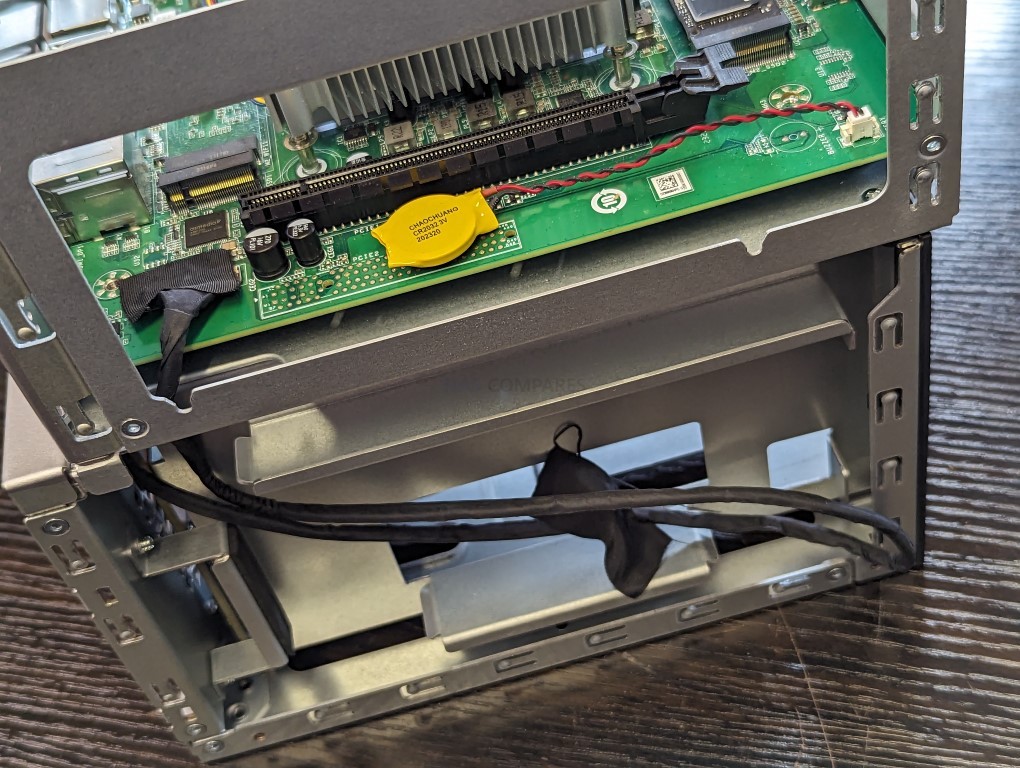
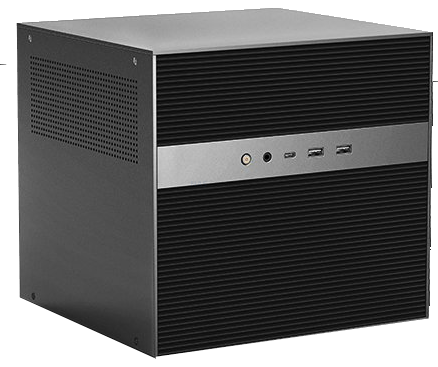
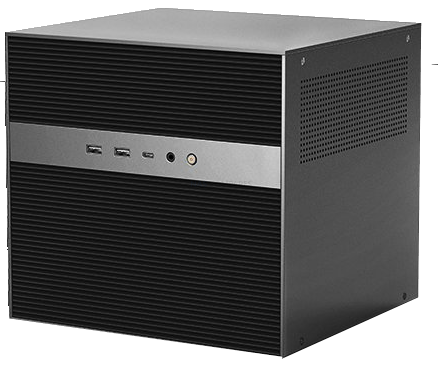



Here is my like only for teach me how to open this front panel. Thank you!
REPLY ON YOUTUBE
Any suggestions for a board with i3 N305?
REPLY ON YOUTUBE
OMG! You gotta stick some GPUs on that bad boy for some benchmarks. This is the ONLY n100 board that comes with a PCIe x16 slot. I honestly would just by the board from them and call it a day.
REPLY ON YOUTUBE
Hi, the Zimacube NAS seems like a very interesting device!
I have just finished a power efficient unraid build on a topton
I have a few questions before i’ll crouwdfund the pro (i5) version.
1. Whats the idle power usage when the server is doing nothing (with something like Unraid running) and all disks spun down?
2. Does the bios have an option to always power on the system when power is provided to the system no matter if the system is cut off power abrubtply or a propper shutdown (i like to shut down my server unraid after midnight and start it by activating a smart plug when i need it and my topton mobo )
3. Are there really 2 DDR5 SoDimm slots in the i5 version and do they support 64Gb of (non eec) memory because i have 2 dims on the shelf.
Thanks in advance!
Rgds,
Mart
REPLY ON YOUTUBE
The hardware looks very nice, will be interesting to see how it works with software.
REPLY ON YOUTUBE
Even though i cannot afford such things, always nice to see new ways of doing things, and giving the public more options on what they want to buy or need.
Very nice
Hopefully more companies will get into this market as you can be sure many people would love a nas that independent from fixed software.
Good to see it made it to production, and will be interesting to hear what people say about it in the wild.
REPLY ON YOUTUBE
This looks really interesting. I’m looking to replace my dead Drobo 5 bay Direct Attached 5D box. I’ve got about 16 TB of data on 5 drives (currently backed up onto a single 18TB USB drive which scares me.
Does anyone know if A) Can the CasaOS mix and match drive sizes like the Drobo does so elegantly so that I can upgrade from the 14TB drives I have to put in the ZimaCube to get going with 18TB or 22TB drives as they become affordable and my 14TB drives age out or fail?
B) any possibility of just putting my old Drobo Drives in and having CasaOS recognize them and use them so that I can just start slowly swapping them out one at a time for the newer 14TB drives I have? (saving me tons of copy time) and keeping lots of folders and installed software working maybe.
Thanks in advance and thanks for the videos!
REPLY ON YOUTUBE
I’m coming from a Drobo environment. Been in it for decade. My Drobo 5n is no longer functioning. This seems to be a product that operates simularly, or am I incorrect? I’m looking for a replacement for my 5n.
REPLY ON YOUTUBE
HuntKey! Haven’t heard that name in a while. I bought one of their computer cases ~2006 in Zhongguancun. Nice case.
REPLY ON YOUTUBE
Looks like a great system, and it is nice to see other manufacturers entering the market. My main concern and one I was hoping woul[d be addressed is the lack if memory over 32GB. I run TrueNAS Scale, and memory is key to performance in that configuration.
I was hoping this system would support at keast 64GB of Memory(Maybe it can??) so I could literally purchase and migrate my system, by slotting in my existing drives.
Overall though looks like a good rig.
REPLY ON YOUTUBE
I bought a zimablade and now i regret not buying this. Would have to put it in my bedroom though (i still live with my parents) so noise would probably be an issue anyway
Someone covince me not to
REPLY ON YOUTUBE
Prices seem to be very much higher than anticipations, and about 600 for the base and over 1000 for the higher model.
Or have I misunderstood this very confused campaign?
REPLY ON YOUTUBE
The PSU is a very trustworthy brand and has been in the market for a very long time.
REPLY ON YOUTUBE
Thanks
REPLY ON YOUTUBE
Would like to see how well pretty ITX motherboards fit too… Seems like if the motherboard and company die, it’d just be throwaway?
REPLY ON YOUTUBE
My main issue I am finding for NAS units like this is basically you can’t really upgrade them later down the road via new motherboard, for example. Not to mention the absurd price premium that tends to be charged for the CPU and ram.
I would absolutely love something like Qnap’s TVS-h1688X-W1250-32G but 3 grand for basically a small server grade motherboard, a low end Xeon that isn’t all that expensive at all even at launch is absurd.
The price premium for the hardware that I cannot upgrade later without buying an entirely new device annoys me to no end.
REPLY ON YOUTUBE
They mentioned sd card support for that 6+1 bay design, that one slot is multifunctional with sd card support.
I didnt see anything related to that here
REPLY ON YOUTUBE
0:33: ???? The video discusses the Zimac Cube, a device from the company IW that is currently in its early stages of crowdfunding and has received significant investment.
3:22: ???? The video discusses the features of an external power supply unit (PSU) and the difficulty in opening the front panel.
6:39: ???? The video provides a guided tour of the internal components of a computer module.
10:22: ???? The video discusses the increasing legitimacy of crowdfunding products and the lack of updates in the STXA program’s kickstarting campaign.
13:38: ???? The video showcases the different connectors and slots available in a mobile computer.
17:58: ???? The front panel of the device was difficult to remove, but the individual fans inside are standard and can be easily swapped out.
20:36: ???? The video discusses the USB and Thunderbolt connectors on the N100 and I5 versions of a device, along with the port and connections on the rear.
24:04: ???? The video is a review of an impressive and well-put-together case with high bandwidth connections.
27:59: ???? The speaker discusses a six Bay device with six SATA Bays for storage, PCI expandability, and a combined hardware-software solution.
Recapped using Tammi AI
REPLY ON YOUTUBE
2 question:
1. Can the iris graphics be used if both RAM slots are used for the i5
2. Can I add an external HBA card and add more drives that way into the system easily.
REPLY ON YOUTUBE
A few backers will be disappointed that they did not get theirs yet after seeing this
REPLY ON YOUTUBE
If this is the ZimaCube, the fact it comes with the 4xNVME board is strange as KS specs for this unit does not include this. Have they changed spec or did they send a hybrid unit. Its important as teh price point vs what was shown could be different.
REPLY ON YOUTUBE
Is the aluminum finish closer to a raw aluminum or does it have an anodization? The KS campaign makes it look darker gray, kind of like Apple’s Space Gray. On this video it looks more silver. I would also like to know more about the TB4 capabilities when you find out more. That is the big pull for me but still not sure what it can/can’t do yet. Thanks for these videos!
REPLY ON YOUTUBE
Front panel is fuuuuuugly. So much better without it. Should be a mesh fabric.
REPLY ON YOUTUBE
Or buy a dell r630 with 2 Zeons, 256GB of Ram, more pcie lanes you can throw a stick at, 10 drive slots. SAS and SATA, an idrac….. The list goes on.
I think an N100 only has 9 pcie lanes? More on the i5 but still
REPLY ON YOUTUBE
“Star” being a technical term for Torx?
REPLY ON YOUTUBE
Thank you for the very review.
Probably going to back the I5 version. Casa OS might also be interesting as it is more consumer friendly. Good for the rest of the family.
Nice Casio watch! had the same in 1987 in highschool.
Looks new??? would love to get one again.
Better fans and dust filters would be welcome.
REPLY ON YOUTUBE
This case is screaming out for a power cord hook. Just to take some strain off the port, if nothing else.
REPLY ON YOUTUBE
I was thinking about investing but delivery may 24 is too long to wait.
REPLY ON YOUTUBE
I was thinking about investing but delivery may 24 is too long to wait.
REPLY ON YOUTUBE
The creator pack is looking really juicy, i hope they will be able to create more space for add-in cards
REPLY ON YOUTUBE
The creator pack is looking really juicy, i hope they will be able to create more space for add-in cards
REPLY ON YOUTUBE
I can see one improvement already. All the main covers should really be a single cover like a computer. That’s just too many darn screws and panels to remove. Here’s the Nas I built myself a while back and still use it today. https://jaimenow.blogspot.com/p/norco-itx.html?m=1
REPLY ON YOUTUBE
I can see one improvement already. All the main covers should really be a single cover like a computer. That’s just too many darn screws and panels to remove. Here’s the Nas I built myself a while back and still use it today. https://jaimenow.blogspot.com/p/norco-itx.html?m=1
REPLY ON YOUTUBE
It would be nice to test out 32GB RAM with this. I know N100s only officially support 16GB but most boards have no problem with more. It would be interesting to see if Casa OS would play okay with that.
REPLY ON YOUTUBE
Looking forward to real world file transfer bandwidth tests over 10 gigabit and how effective SSD caching is.
REPLY ON YOUTUBE
It would be nice if you explore the HW a little more. Is main M.2 full x4 PCIe? Is second M.2 on the board fully x4 PCIe? Is the exposed sata port on the board functional? How many lines effective has the x16 PCIe slot? Is the x16 PCIe slot support of bifurcation? If yes, in which configurations? What is the number of PCIe lines dedicated for M.2 expansion?
All of this can tell much about the expandibility of the system.
REPLY ON YOUTUBE
Enough little things that add up to a dealbreaker for me. Maybe a 2.0 version might be better.
REPLY ON YOUTUBE
Wow! This is to me a prime example how crowdfunding should be done and result to.
Other crowdfunding should take note!
I really like this one a lot: I love the fact they use an (external) “standard” power-brick and connector(!), btw, it is often called “DC in”, not “DC out” on a chassis 😉
Those power-bricks, with our QNAP’s at least, are notoriously failing but are very easy to replace.
I also love the fact, well, fingers crossed the final version will have it too, still plenty other connectors (and thus capabilities) to expand this into a more DIY project. (unless they disable it via the bios, that would be a bummer).
I personally would always go for the i5/higher-powered version as history shows that once you really starting to use a platform, you often will also “expand” your desires & wants.
Indeed, cooling would need attention.
And I also wonder about any LED indicators, it looks a bit omitted?
I’m not a crowdfunding-fan as I see it as gambling, and I really do not gamble at all, but if I was to be in the market for such, this would definitely be the first and the one I would seriously consider, it really, really looks very good and promising.
Winner-winner, chicken-dinner!
No seagulls were heard in producing this video, thank you Robbie!
PS: In the review of your website, perhaps, when the final version is released you can also review all the remaining connectors on the MB.
REPLY ON YOUTUBE
Would like to know what those drive cooling fans are as they look non-standard (i.e., hard to source if they fail) to me. I’ve been bitten by that problem before (looking at you, Drobo). Would have been nice to have an internal USB socket (like LincStation) for us UnRAID fans too!
PS – Congrats on the play button. Hadn’t noticed that before.
REPLY ON YOUTUBE
Very impressive. I like the way the drives are connected to a printed circuit backplane then the backplane is connected to the motherboard with one ED1 cable and one power cable, this is much better than a knot of SATA cables. From the video it appears that the motherboard and the drive bays are in their own metal boxes which are bolted together rather than a shelf in a unitary box. In other words the drive bays are like an expansion box. One advantage of this design is Icewhale could bolt another drive bay box to the bottom (assuming the CPU had enough lanes) have a 12 bay NAS. From the videos I have seen it looks like CasaOS does a decent job of running docker containers but is fairly limited in basic NAS stuff like sharing and backup. I hope Icewhale takes a good look at Open Media Vault that seems to have a pretty good disk sharing interface (but has angered some users with the change in the OMV interface to Docker). Unfortunately, OMV seems to have performance issues and one YouTuber used that as an excuse to switch to Proxmox. With ZimaBoard I only need Docker with ZimaCube I need a full scale NAS comparable to Asustor or Synology 4 bays. At the price point I am on the edge, and the next few versions of CasaOS will be the tipping point. I would consider UnRAID OS, but would only consider TrueNAS Scale if my needs shifted and I needed Kubernetes (or there was a radical simplification in the Kubernetes interface).
REPLY ON YOUTUBE
This vs synogy 1821+?
REPLY ON YOUTUBE
I believe it’s not SATA but SAS connectors for specific hdd
REPLY ON YOUTUBE
The hardware is really intriguing, but CasaOS really offers next to nothing out of the box in terms of storage and network management. Certainly, it can be extended by using the underlying OS and/or suitable Docker containers, but it’s not at all comperable to a tyical NAS solution as shipped.
I think if i got one, it would take me about 10 minute before i started installing TrueNAS or unRAID.
REPLY ON YOUTUBE
By the 2nd NVME, their appears to be another connector right below it, looks like another small nvme, can you confirm what it is.
REPLY ON YOUTUBE
Thanks as ever Robbie / NASCompares for the brilliant videos (great choice to get this out ASAP as an almost 1-take ????).
I’m already looking forward to the further power/noise/performance tests when you are able to get hold of ZimaOS ????
I’m watching with interest, as I still can’t decide whether to back the ZC std or the LincStation N1
(as relatively cheap as the N1 is, I can’t really justify both that and the ZC ????I’m up for an all-SSD NAS and my gut says back the smaller/cheaper N1, but the more expensive ZC would give more flexibility for different drives in the future ????I think I’m going to wait to the end of the campaign, as much info still seems to be ‘changeable’ ????)
(1) Worth noting that your review unit seems to be an earlier (prototype?) motherboard revision!
ZC Update2 on the KS page, shows a photo of “N100 Model Phase Two prototype” motherboard, with several differences, inc:
– The Large pin header above SODIMM connector is now discrete connectors (inc 2x SATA ??)
– MB USB socket to right of SODIMM (Good for UnRAID ✅????)
– 2x PCIe connectors (1 x8, 1 x16 – Surely the N100 won’t have both??)
(2) The ZC N100 pledges have the text “Note: This reward does not include disks or the quad M.2 SSD adapter”… which I’m reading as them wanting to show it’s different from the ZC Pro (but that the ‘Dual’ M.2 via U.2 slot is included ????)
(3) I’m hoping the N100 includes a stretch goal of 16GB of memory for a small up-charge (32GB would be better, but I know that is officially not supported, despite working fine by all accounts). I’m factoring in +£70 for a 32GB DDR SODIMM + £50 for an UnRAID licence, for my own preferences (I’d hate to have that 8GB memory go to waste!)
(4) The “Your questions answered” email from Allen Shen of IceWhale (on 09 Nov 2023) actually stated that the Early Bird Backers would also get “$100 Cashback to your PayPal account” (or a $100 voucher for use against add-ons)… This seems surprising, but changes the overall price to even more good-value!
Cheers again, D ????
REPLY ON YOUTUBE
Awesome video. When you get the proper unit, I would like to see the power consumption of it. It will be interesting to see wattage when idle and running.
REPLY ON YOUTUBE
The design does baffle me,:
The front panel is totally useless and hard to remove, it could be a dust filter mesh board.
They could fit a 1U PSU or a DC-ATX power board there but choose to go with an external PSU.
REPLY ON YOUTUBE
looking forward the power draw test later
REPLY ON YOUTUBE
Nice one, I have few comments:
1- how are the case fans controlled? on/off or PWM?
2- the PSU is 220W (around) – I was thinking twice putting 450W in my N3 but here is 220W only – that should be plenty but still
3- it is super nice to have 5x M2 – super nice comparing to my Topton (here only 2 and both went as OS disks in mirror) – one can have extra 2+1 pool
4- how about HDD and LAN LEDs in front?
Overall super nice basis for something excellent – of course I would not stick to their OS but the hardware seems OK. All depends on final price.
EDIT: I had to: @27:22 – “celeron PSU” – nice one 😉
REPLY ON YOUTUBE
Eh. The price for the Pro version is too high even with the early bird discount, I think I’m about to get financially kicked in the ass and likely can’t afford it next month anyway, and I think I want more than 6 bays anyway, so that kind of rules this one out for me.
REPLY ON YOUTUBE
I’d like to know how those 9 gen3 lanes are distributed, would love to see diagram released
REPLY ON YOUTUBE
*UPDATE* – As mentioned in the video, Power consumption, noise tests, temperature tests and performance tests are all on the “to-do list”. I am just waiting for IceWhale to drop the specific/featured release of Casa OS for this device first, as that will play an enormous part in getting realistic operational data. Any test I perform on this now, whilst it is running the general version of CasaOS, will be immediately invalid when the version that is intended for this device if/when it starts fulfilment is released. Hoep that makes sense and I will be factoring this into a few other direct comparison videos soon too! Have a fantastic weekend!
REPLY ON YOUTUBE
would like to see icewhale create a separate option for customer on a budget. maybe implement a system like the brand Framework. Some NAS diyer would like to make a custom NAS where the motherboard has the required ports to connect to 6HDD and not buy a seperate adapter that will take alot of space. Like your Jonsbo video. maybe icewhale can create a barebone Zima Cube.
REPLY ON YOUTUBE
i would be interested in seeing power consumption comparisons with this model. it would be cool to have that compared with the zima edge to see how they are different and also in comparison to your jonsbo budget diy nas to get things into perspective.
REPLY ON YOUTUBE
This is what I’ve been waiting for.
REPLY ON YOUTUBE
*Update* – You can find the (now LIVE) Zimacube Kickstarter Page here – https://bit.ly/47mjSTY
REPLY ON YOUTUBE
Got an email today that the Kick Starter is Live.
The prices are pretty high as expected for a high spec unit.
REPLY ON YOUTUBE
I signed up for the 1$ reservation fee and now that the kickstarter is live it seems to be that the 1$ reservation fee was a total 100% scam. There is NO DISCOUNT for those with the reservation as promised. There is NO RESERVATION, anyone can buy. The only thing a reservation holder has, is 1$ less in his pocket. Also the prices are really quite high for a new brand with ZERO reputation. And I wonder if customs charges are included or will be added (I’m in the EU – the FAQ does not mention anything related to duty/customs/tariffs).
REPLY ON YOUTUBE
This would be my first time purchasing something like this. Does anyone happen to know if these come with RAM already provided at a lower configuration and later on able to upgrade it or do I need to provide my own RAM and this is like a barebones system?
REPLY ON YOUTUBE
Put in my $1 for “Creator” (includes Nvidia graphics card) and it goes live 1 PM EDT today.
They plain i5 model was “sold out”. Some AI libraries use Nvidia as a math co-processor using its “Cuda” language.
Otherwise I might just remove the graphics card. Very impressed with hardware specs; very concerned about software.
The lack of integration in CasaOS reminds me of Windows 3.1. TrueNAS is too complicated for my modest Docker needs.
So, I might try UnRAID either with this system or the LincStation. Although my Docker needs are modest, I do need access to command line Docker see the book, “Docker for Data Science”. Although CasaOS permits command line Docker, it generates confusing messages in the CasaOS dashboard. See my “competent_borg” rant. What I am looking for is a system that makes it easy to load and go PostGIS/PostGIS (PostgreSQL) container and Juypter data science containers. Not just for my own use, but to do so like “cattle” (not “pets”) for other users. There are a lot of use cases for “maps and crosstabs”: epidemiology, census demographics, politics and marketing. I am working open source, but as a stand alone product think Tableau.
REPLY ON YOUTUBE
The Kickstarter page is available on preview from a few hours ago.
– Goes LIVE at 17:00 (London Time) on Fri 03 Nov 2023 ✅
Assuming they don’t change the details, from the preview page…
– ZimaCube: 3905 HKD / 499 USD / 410 GBP (NO Quad NVMe adapter!)
– ZimaCubePro: 7035 HKD / 899 USD / 740 GBP
– Delivery: March 2024 delivery!
Prices above for those who paid the $1 to get access to the ‘Early-Bird’ pricing (Max-500 backers), everyone else is $100 more.
This Kickstarter is said to close around 12-Dec-2023
REPLY ON YOUTUBE
Someone know when it will be released and shipped?
REPLY ON YOUTUBE
Most interesting broadcast. 10Gbe is a showstopper (alternative product is Asustor FS6712X). If 6 x Rotating Rust, and 4 x NVME, then correctly using NVME as a fast file system cache would be a win for all customers……..
REPLY ON YOUTUBE
Would definitely like to know how much power the Zimacuba consumes with and without drives.
REPLY ON YOUTUBE
Signed up with the $1 reservation fee today (both standard and pro), purely as it’s piqued my interest. More than anything, the question about 3rd party RAID OS is what I’d like confirmed if you do get a unit. Started playing with UnRAID and quite like it, and for my needs this hardware should be ideal (and convenient!)
REPLY ON YOUTUBE
hello someone know what is creator pack?
REPLY ON YOUTUBE
Just for an email to “reserve a place” so it’s going live in a few days on kickstarter
REPLY ON YOUTUBE
I think the mayor missing features is using an i7 which allows AMT support, together with 2x10GbE
REPLY ON YOUTUBE
0:09: ???? The video discusses the Zimma Cube, a crowdfunding product in development, and addresses common questions about it.
3:30: ???? The video discusses the features and pricing of an Intel i5 uh with six satBay, Gen 2 and vme Slots, and PCI upgrade ability at Gen 4.
6:55: ???? The Thunderbolt 4 connectivity on the device allows for seamless network switching and direct connection to Mac devices.
10:21: ???? The video discusses the connectivity and lane speeds of the M.2 NVMe slots in the Zimma Cube OCTA and Pro.
13:35: ???? The video discusses the possibility of using third-party operating systems on the Zimmer board and the cooling system of the device.
16:56: ???? The video discusses concerns about the lack of information on thermal and cooling data in the upcoming Kickstarter campaign for a barbecue product.
20:27: ???? The N3 system has additional active cooling, more space for CPU fans, and the possibility for more aggressive CPU coolers.
23:45: ???? Users are annoyed about the use of external power supply units (PSUs) in NAS devices.
27:17: ???? The video discusses frequently asked questions about the dimensions and compatibility of the Ice computer.
Recap by Tammy AI
REPLY ON YOUTUBE
Seems like the Pro version will be quite expensive, at the indicated price.
I suspect I could build a functional PC system with Thunderbolt for less, which might be the better option ????????♂️
REPLY ON YOUTUBE
Why answer straight forward questions with bloated vague responses filled with “wank words”. Whatever happened to “Yes” or “No”?
If they can’t commit to simple answers, I can’t commit $.
REPLY ON YOUTUBE
“Risks of Default Passwords on the Internet”
https://www.cisa.gov/news-events/alerts/2013/06/24/risks-default-passwords-internet
REPLY ON YOUTUBE
That’s an awful lot of marketing speak which I’d be wary of on Kickstarter. They have past successful campaigns as a plus, but even that’s no guarantee (looking at you, Pebble). PS – your chapter timings are somewhat out of whack.
REPLY ON YOUTUBE
I like the external PSU. Power supplies are a common failure point, and having a external one removes the need for disassembly and cable routing during replacement. In addition to saving space in the box, they remove a large source of heat.
REPLY ON YOUTUBE
Still leaning DIY with that pricing but thanks for keeping an eye on this. I’m not a fan of the external PSU either, as the one on my Synology comes unplugged very easily compared to an ATX plug.
REPLY ON YOUTUBE
N100 only has 9 PCIE lane(gen 3.0), 1235U has 20 PCIE lane(gen 4.0).
For anyone considering an N100 NAS either DIY or pre-build, it’s a good choice on paper, but with very limited PCIE lanes, and poor E-core performances, you will have a decent NAS but with nothing fancy.
REPLY ON YOUTUBE
thanks to you, I just built DIY NAS, based on Jonsbo N3 and Topton N6005. Added 2x32GB RAM and 4x 6TB WD Plus. Added 5 Noctua fans (including replacement of CPU one). Total cost: 930GBP
REPLY ON YOUTUBE
Hi, just a short question unrelated to Zima Cube. What do you think of using the intel datacenter U.2 SSD instead of M.2 NVME for storage or cache. Recently Ive seen a lot of second hand Intel U.2 SSD in the used market therefore I’m interested to know what do you think?
REPLY ON YOUTUBE
FWIW, another reputable site mentioned early bird pricing — which apparently came from IceWhale — of $300 for the Cube and $800 for the Cube Pro. The $500 and $1000 tiers you suggest is likely to lower the ceiling for their potential market, and would definitely make DIY a rather more attractive option for many of us. And the TrueNAS Mini and Mini+ are probably better comparisons for the Pro model than the QNAP TVS-h674 despite 5 vs 6 HD bays, and much closer in price, at least for a storage-focused device.
REPLY ON YOUTUBE
CASAOS Questions (setting up my ZimaBoard)
1. Update: Does the “CasaOS update” update the underlying Debian operating system? My natural instinct when seeing a Debian or Ubuntu command line is to run sudo apt update. When I ran apt update with –yes it seemed to override some hand crafted CasaOS settings and wanted to update the firmware. If CasaOS does not update Debian and Debian update is not recommended then how does one deal with the evolving threat environment CVEs?
2. Admin / Admin vulnerability — By default Port 22 is left open with default userid, password and host name. This is similar to Admin/Admin on a router or Raspberry Pi where the default user with admin privileges is Pi with a password of Raspberry. At least Raspberry Pi encourages users to change the password.
3. Terminal — the default web based terminal seemed to lag and it was not recommended for command line “curl” command updates. Windows 10 has an OpenSSH client built in (and an optional OpenSSH server). In the Raspberry Pi documentation I saw instructions for connecting to Raspberry Pi using Windows Terminal with SSH using an SSH Key rather than a password. Also in Raspberry Pi documentation I saw connecting to Raspberry Pi using VS Code on Windows which would be similar to using VS Code to connect to WSL on Windows for Docker. This is mostly a documentation issue, so I would suggest looking at the Raspberry Pi documentation to get a model for security and connectivity documentation. You don’t have to reinvent the wheel you just have to make sure it works with CasaOS.
I have shutdown and unplugged my ZimaBoard because I do not want to leave it on in an unprotected and potentially unsafe state.
REPLY ON YOUTUBE
Been thinking if I should wait for this one, or build a custom one based on i3 12th gen (dont really need 4x eth ports in pro version, while N100 not sure if its not too slow)..
REPLY ON YOUTUBE
What a load of marketing wank.
REPLY ON YOUTUBE